Last updated on January 10, 2024
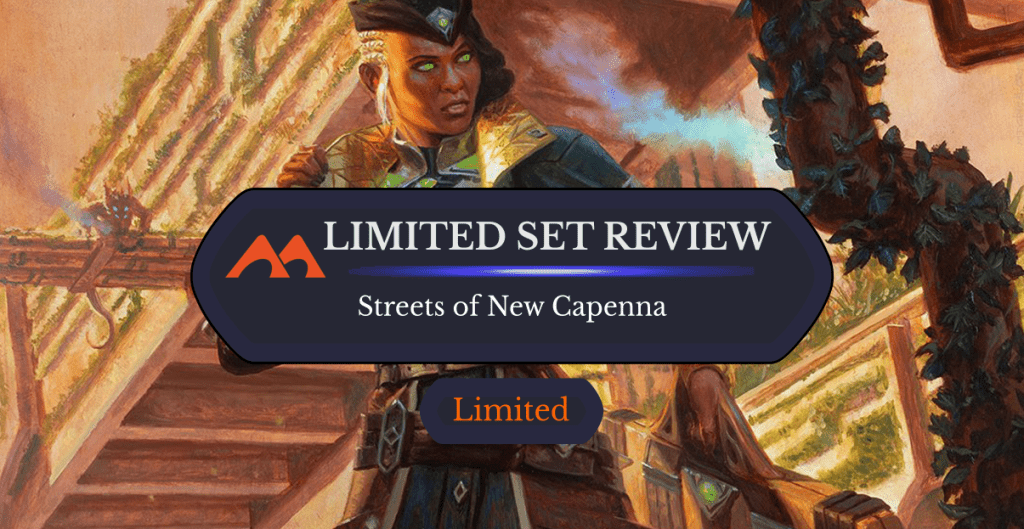
Vivien on the Hunt | Illustration by Jake Murray
Editor's note: Draftsim now has a full Streets of New Capenna draft guide from limited expert Bryan Hohns. Be sure to check that out for a full strategic and archetype analysis of the set.
I love multicolored Magic sets. From Shards of Alara to Khans of Tarkir or Ravnica to Strixhaven, most of Magic’s forays into multicolor have been huge hits for Limited and great fun to play. Today I’m going to take a deep dive into the world of demon crime lords and lavish parties in Streets of New Capenna, and talk about each card’s application to Sealed Deck and Booster Draft.
As always, just a quick reminder that these reviews are based on my initial impressions of the set. There’s no way to tell how fast or slow the format is (though a 3-color set is highly likely to be slower than the average set) or how good each of the draftable decks are going to be without playing the set. So I’m reviewing each card assuming that the archetype it’s designed for is actually playable. My hope is that these insights will help inform your decisions in your first attempts at playing the format.
Let’s get started!
Rating Breakdown
I’ll underscore the review for each card with a rating out of 10. Here’s what each of the ratings mean:
- 10: The absolute best of the best. 10s make a meaningful impact on any game regardless of when you play them and are extremely tough to beat. Cards like Ao, the Dawn Sky or Junji, the Midnight Sky.
- 8-9: Extremely good cards, usually game-winning bombs and the most efficient removal spells, though not quite good enough to be a 10/10. Cards like Kyodai, Soul of Kamigawa or Behold the Unspeakable.
- 6-7: Important role-players. These are typically the best uncommons that really drive you towards playing a particular color, like build-arounds and good removal. Cards like Kappa Tech-Wrecker or The Fall of Lord Konda.
- 3-5: The average Limited card. Most commons and uncommons end up in this range and most of your Limited decks are made up mostly of these. Cards like Jukai Preserver or Skyswimmer Koi.
- 1-2: These cards are generally pretty bad and ideally you won’t play any of them. They should be kept in the sideboard and might be useful in specific situations. Cards like Reckoner Shakedown or Planar Incision.
- 0: Absolutely awful cards. Virtually unplayable in every scenario and you should never put these in your deck. Cards like March of Burgeoning Life.
Before we get into the cards, let’s talk a little bit about the set’s mechanics and the color combinations you can expect to draft.
Set Mechanics
The Brokers and Shield Counters
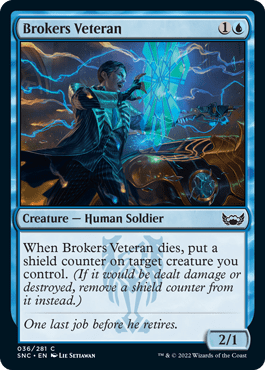
The Brokers are the Bant () crime family. Their unique mechanic is shield counters. These are counters that act very similarly to the regenerate mechanic, where if a permanent has a shield counter, the next time it would take damage or be destroyed you remove the shield counter to prevent that damage or destruction.
The Brokers also have a broader focus on counters. This is a very straightforward mechanic that add a lot of value to a creature. But it does have a downside in that any source of damage will remove it, so a 5/5 that’s chump blocked by a 1/1 loses its shield and leaves it vulnerable. If you can effectively manage this downside then this mechanic should make it so that your creatures are extremely difficult for your opponents to kill without losing multiple cards.
The Obscura and Connive

The Obscura are our Esper () crime family and their mechanic is called “connive.” If a creature connives, you draw a card and then discard a card. And if you discarded a nonland card this way the creature gets a +1/+1 counter.
Looting is always a great mechanic since it gives you a way to smooth out your draws and find more of what you need each turn. The discarding helps with the graveyard-based themes of blue/black, and the counters help overlap with the brokers’ mechanic, making this a nice bridge to other colors as well as being a strong mechanic in its own right.
The Maestros and Casualty
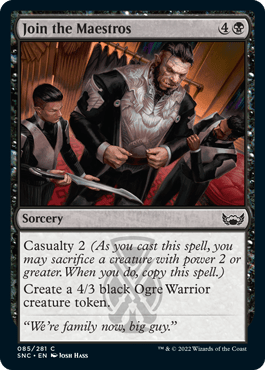
The Maestros and their casualty mechanic are the Grixis () family. Casualty lets you sacrifice a creature as an additional cost for a noncreature spell to get an extra copy of that spell. A lot of these spells are perfectly functional without copying them, so this is largely just a free bonus.
Sacrificing creatures works very well with the Riveteers and there are a lot of creatures in this set that benefit from being sacrificed. You'll want to make sure your deck is filled with plenty of good fodder to really maximize your casualty spells.
The Riveteers and Blitz

The Riveteers are the Jund () family and their mechanic is called blitz. Blitz is an alternate casting cost for creatures that grants them haste on entering, lets you draw a card when they die, and forces them to be sacrificed at the end of the turn.
They also have a broader theme built around sacrifice. There are ways for you to blitz your creatures and then sacrifice them for benefits in addition to getting to draw the card from the blitz mechanic. Sacrifice and aristocrats have historically been a great archetype and I see no reason why it won’t be good now. It also overlaps very nicely with the Maestros’ casualty mechanic as an easy way to create sacrifice fodder.
The Cabaretti and Alliance
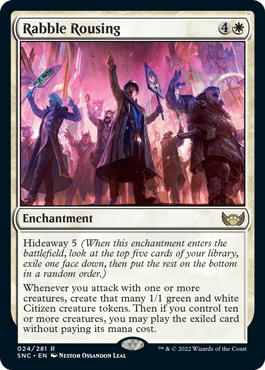
Maybe the simplest mechanic in the set, alliance is the Naya () Cabaretti crime family’s mechanic. Alliance is an ability word, similar to landfall, that has no real meaning but indicates an ability that triggers whenever another creature enters the battlefield.
The Cabaretti are a token-themed family that benefit you for making lots of creatures each turn. A lot of these alliance triggers get better the second time they trigger, making double-creature turns very valuable.
Draft Archetypes
This set functions quite a bit differently from regular Draft sets. While you normally draft 2-color decks and have the potential of splashing a third color, you’re actually more likely to draft 3-color decks and have the option of splashing a fourth color in New Capenna Draft.
And since the crime families each overlap by the 2-color allied pairs it’s also possible draft archetypes. So there are still 10 archetypes to draft and they appear to be broken down like this:
- Azorius (): Counters matter
- Dimir (): “Threshold/Delirium” requiring five or more mana values among cards in your graveyard
- Rakdos (): Sacrifice
- Gruul (): Treasures matter
- Selesnya (): Citizen tribal
- Brokers ()
- Obscura ()
- Maestros ()
- Riveteers ()
- Cabaretti ()
Because you’re drafting decks with more colors there will be more mana fixing available and you’ll generally value it a lot higher than in normal sets. Double color symbol cards are generally harder to cast and go down in value, which is worth bearing in mind.
Now without any further ado, let’s jump right into the cards themselves!
White
Angelic Observer
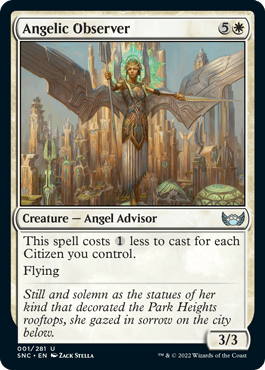
Rating: 4/10
While it’s hard to know just how many citizens you’re likely to have in play at once, Angelic Observer seems like only a slightly above average playable when it works. You need three citizens to feel like you’re getting a great deal. And even if you could get five a 3/3 flier for one mana isn’t quite as impactful as you’d want it to be by the time that happens.
Backup Agent
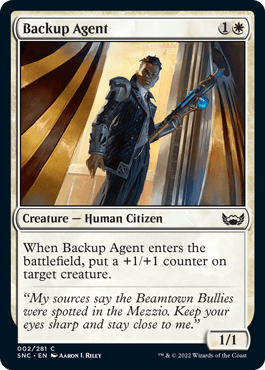
Rating: 5/10
Dauntless Survivor and other similar cards always look weak but end up playing out really nicely. Backup Agent can just be a vanilla 2/2 if that’s what you want, or you can buff a different creature and still be happy. Either way this is a good deal and a solid common.
Ballroom Brawlers

Rating: 3/10
For a creature that wants to be attacking a 5-mana 3/5 isn’t particularly exciting. Even worse is that Ballroom Brawlers’ double white mana cost isn’t trivial to achieve in a 3-color set. This isn’t exactly terrible, but I don’t see it being particularly good either.
Boon of Safety
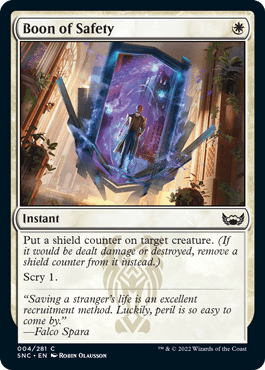
Rating: 5/10
A card that’s very reminiscent of Gods Willing, I expect Boon of Safety to do quite a lot of work in aggressive white decks for this format. Protecting a creature against most removal spells and against losing in combat for just one mana is a good deal, and the scry 1 is an upgrade you’re definitely happy to see.
Brokers Initiate
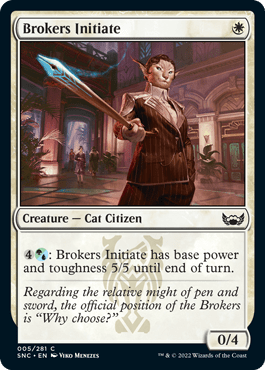
Rating: 3/10
I’m not particularly enthralled by a 1-mana 0/4 with this ability, but what I do like is that Brokers Initiate is a citizen. Even if you’re not activating the ability very often, having this as a 1-drop for that deck should be very reasonable. Once you do get to five mana, having the threat of becoming a 5/5 live is going to be very relevant.
Buy Your Silence

Rating: 4/10
Five mana for a removal spell is quite a lot, but exiling anything is great. Secure the Scene was a bad card because giving a 1/1 token to your opponent means they at least keep some board presence. Giving a Treasure token instead, while not nothing, is enough of a downgrade to make Buy Your Silence a fine playable.
Celebrity Fencer
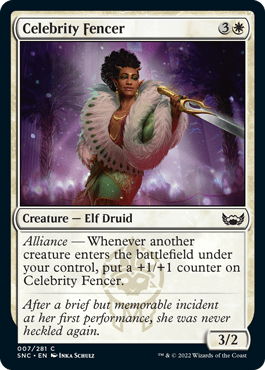
Rating: 3/10
Getting +1/+1 counters is a very good upside for an alliance trigger, but the base rate of a 4-mana 3/2 doesn’t excite me much. If you can play Celebrity Fencer on curve then you’re likely to get a few triggers off it, but the odds of you having more creatures starts to go way down if this comes down on turn 7 or later, making this a very weak card to play.
Citizen’s Crowbar

Rating: 7/10
I’m a big fan of these recent card designs that give you an equipment and a creature token at the same time. Citizen's Crowbar is just a 2-mana 2/2 citizen, which is something you actively want in a lot of decks. But it also leaves behind a very relevant piece of equipment when it dies. That’s all I need to know to make this a very high draft pick.
Dapper Shieldmate
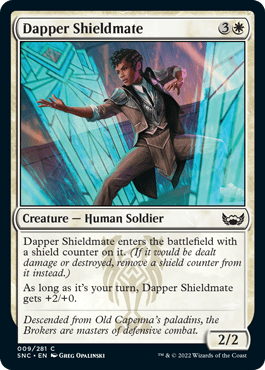
Rating: 3/10
A 4/2 for four mana isn’t that impressive, and the shield counter doesn’t go too far towards changing that. Dapper Shieldmate trades down, but of course the shield counter often forces it to trade for two creatures. But those can be a 1/1 citizen token and a 2-drop, meaning your four mana still didn’t go very far.
Depopulate
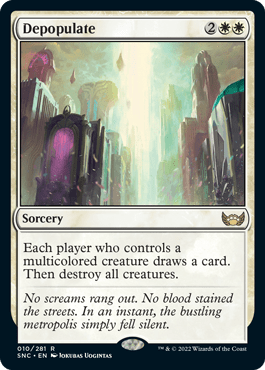
Rating: 7/10
There are enough multicolored creatures in the set that Depopulate is likely to let both players draw a card, but a four mana Wrath of God is efficient enough that this should always be good enough. The best way to play this is when you get a chance to rebuild your board afterwards, or if you let your opponent overextend in the early turns while saving your best creatures for later. Whichever way you play it, this is cheap enough and powerful enough to be good in any deck.
Elspeth Resplendent

Rating: 7/10
The hallmark of a good planeswalker is one that has a mode that can protect itself on the board, either by removing an opposing creature or by creating a creature token to block with. Sadly Elspeth Resplendent doesn’t really have that. Its -3 ability can do it and do it pretty well, but only if you find a creature that costs three or less. That can be likely depending on your deck construction, but not being guaranteed is a bit of a turn off.
That said, Elspeth’s +1 ability is really good at breaking board stalls and it makes a decent impact on the board assuming that it isn’t going to be put under too much pressure. While it’s definitely not been the best that Elspeth has ever been, Resplendent should be perfectly reasonable in your white decks in this format.
Extraction Specialist
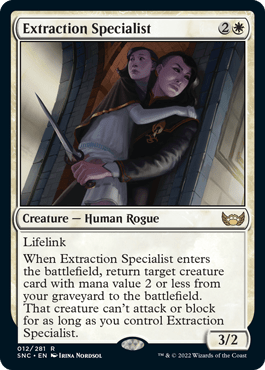
Rating: 6/10
White creatures that reanimate 2-drops never end up being that good, but Extraction Specialist looks like it might be the one that bucks the trend. All it has to do is enter the battlefield which is pretty easy to do. To fuel it you only need play a 2-drop on curve and trade it off.
Even when you don’t have a target for it, a 3/2 lifelink for three is hardly an embarrassing play. The downside of that creature being pacified while you control this doesn’t seem all that relevant. It’s important that you got the creature for free and it’ll eventually be usable.
Gathering Throng
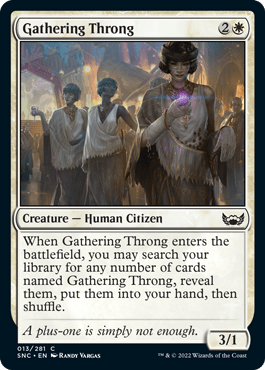
Rating: X/10
These cards are always fun to play with and they’re also very easy to evaluate given that they’re vanilla creatures. Being citizens is a big plus, so what you really need to care about is how many you have in our deck.
If you only have one, it’s a 1/10. The second copy pushes it to an easy 5. The third then puts it into the 6 or 7 range. The more copies you can get the better they become. But Gathering Throng is unplayable and you shouldn’t bother if you only end up with one.
Giada, Font of Hope
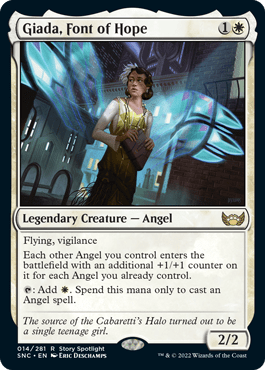
Rating: 6/10
Giada, Font of Hope has quite a lot of text and realistically only two words you actually care about: flying and vigilance. Giada is a great card for those stats alone. The rest of its text is largely irrelevant, but there are a few other angels in the set and three of them at common, so it’s not completely useless.
If you can play Giada on two and then Inspiring Overseer on three, then you’ll feel really good about your opener. But if you never play another angel then you’re also very happy with what Giada can do on its own.
Halo Fountain
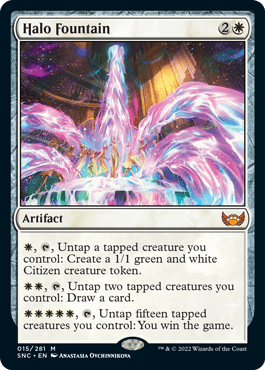
Rating: 6/10
Assuming you’re an aggressive deck that attacks a lot, Halo Fountain basically reads as giving you a 1/1 or an extra draw every turn. But unless you attack a lot, tapping your creatures regularly isn’t a trivial matter, meaning activating this won’t be guaranteed. All-in-all this is a nice payoff for aggressive decks but might end up being too situational to be as good as you want it to be.
Hold for Ransom
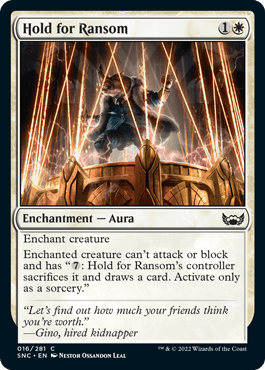
Rating: 4/10
While I’m not a fan of Pacifism effects that can be removed, paying seven is a really significant amount and you do get a card back when they remove it. But these effects have gotten worse and worse in recent years, and the Riveteers colors have ways to easily sacrifice the creature you put Hold for Ransom on. This seems fine when you’re being more aggressive but I wouldn’t want to rely on it elsewhere.
Illuminator Virtuoso
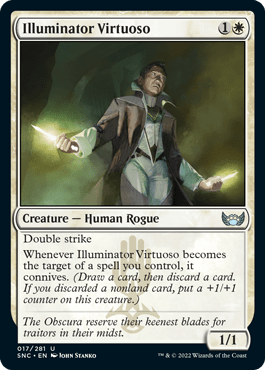
Rating: 5/10
Fencing Aces don’t need much help to become good in Limited, but Illuminator Virtuoso paying you off for using combat tricks on it is a nice buff. Should be a fine card in most aggressive decks.
Inspiring Overseer
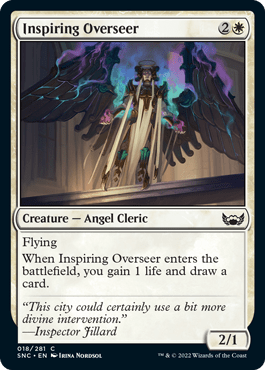
Rating: 7/10
My rating might be a little high on Inspiring Overseer but I want to impress one thing on you: this is the best common in white, and it’s not even close. Priest of Ancient Lore didn’t even need flying to be the best common in Forgotten Realms. If you’re white then you’ll take as many of these as you can find and be happy with every single one of them.
Kill Shot

Rating: 4/10
We’ve seen Kill Shot before and it was never that impressive. If you’re a slower and more controlling deck then it performs fine, but white is often aggressive and those aggro decks just can’t use this effectively.
Knockout Blow
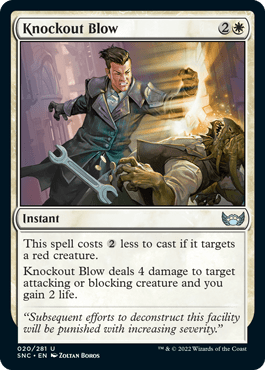
Rating: 4/10
The downside of these cards is always that they require the creature to get into combat before you get a chance to kill it. It’s worth noting for this and the other color hosers that we’ll see, that five out of the ten possible archetypes contain red, making Knockout Blow a little more likely to hit a red creature than normal. That aside, a 3-mana Gideon's Reproach isn’t that great of a card but is still serviceable and gets stronger the more you want to be defending yourself from aggressive plays.
Mage’s Attendant
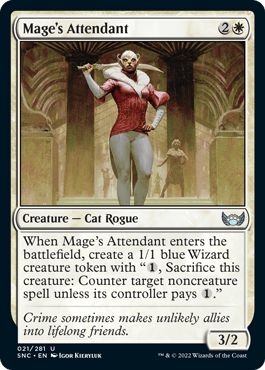
Rating: 6/10
You’d already be very happy with a 3/2 for three that gives you a free 1/1. Mage's Attendant is a card that you’re happy playing with at four mana (Elderleaf Mentor for example). But the 1/1 happens to be a kind of Spiketail Hatchling as well? Sign me up!
Mysterious Limousine
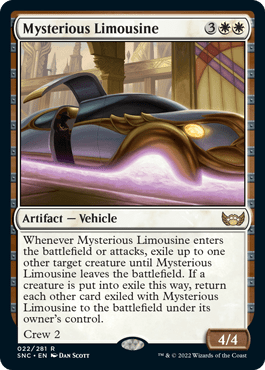
Rating: 7/10
So Mysterious Limousine is a Banisher Priest Vehicle that gets to swap what’s under it whenever it attacks? Okay, I’m in for that. Crew 2 is very reasonable to get this going and you can even exile your own creatures knowing that they’ll come back and retrigger their effects when you get to attack. Double white might end up being a little tricky but it’s worth it for a card like this.
Patch Up
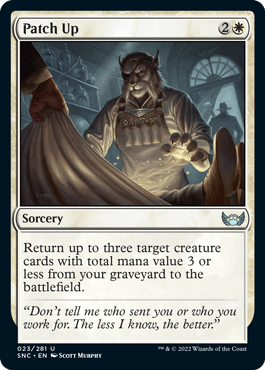
Rating: 2/10
While very reminiscent of Call of the Death-Dweller, Patch Up is probably nowhere near as good. The most common application of this is probably to reanimate a single 3-drop creature, at which point you’d be better off having this be simply a different 3-drop. If you get to reanimate two or three creatures then this is probably worth it, but you’ll need a critical mass of 1-drops to make that scenario a likely one, and I’m not sure that’s going to happen in this format.
Rabble Rousing

Rating: 8/10
Putting the hideaway ability to one side for a moment, five mana for an enchantment that creates a 1/1 token for every attacking creature sounds incredible. Rabble Rousing gives you repeated alliance triggers and plays right into the tribal synergies that Selesnya is trying to do.
Getting to 10 creatures doesn’t even seem unreasonable with a card like this around. Granted, it does nothing when you’re really far behind or have no creatures, but it enables enough synergies that I think it balances out to a very powerful card in a lot of situations.
Raffine's Guidance

Rating: 2/10
There have been a few variations on cards like this, like Sentinel's Eyes and Gryff's Boon, and they’ve always performed pretty well. But I’m not sold on Raffine's Guidance meeting the mark of the versions that came before it since it only grants +1/+1 and is in a set with no enchantment synergies. It’s good as a nonland card you can discard to Connive and still get a bit of value from, but it lacks any kind of impact to make it very appealing beyond that.
Raffine's Informant
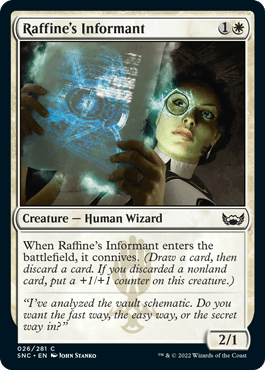
Rating: 5/10
Raffine's Informant is an incredibly solid common 2-drop that’s likely to be useful in all kinds of Obscura decks. Even outside of that it’s simple and does enough to be good in any white deck.
Refuse to Yield
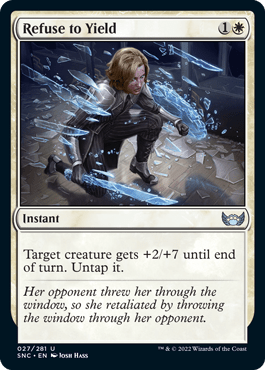
Rating: 3/10
Well, that’s a first for Magic. No card in the history of the game has ever given +2/+7 before. +7 is enough of a buff that Refuse to Yield is likely going to save your creature in any combat it’s likely to be in.
Untapping the creature lets it ambush attackers and the buff is enough that it should get through a lot of potential blockers. I’m not a big fan of combat tricks in general but I think this has enough going for it to be a good one.
Revelation of Power

Rating: 4/10
Revelation of Power is going to feel like a really weak combat trick if you can’t get the lifelink and flying bonus, but it looks great if you do. Lifelink in particular is exactly what you want to help you win races and you’re probably interested in winning races if you’re a deck that wants a combat trick.
Rumor Gatherer

Rating: 6/10
Drawing a card is a fantastic upside for an alliance trigger and one that really incentivizes you to plan your turns so that you get some nice double creature turns in the future. But something that likely holds Rumor Gatherer back is its mana cost.
I’ve mentioned how double white on a 5-drop isn’t trivial, and on a 3-drop in a 3-color format it’s really quite hard to do. But even if you can only play this later in the game the Cabaretti seem to have enough going for them that this is always a welcome addition to the board. If you do get lucky enough to play this on turn 3 then you’ll be well ahead in no time at all.
Sanctuary Warden
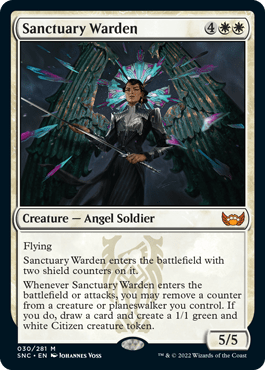
Rating: 10/10
If you can provide a steady stream of counters for Sanctuary Warden to eat it’s basically just a flying Grave Titan. Entering with two shield counters is huge and you can even just eat one of them to get the first ETB trigger.
Even if that’s all it does before being removed you got a great deal for what you spent on it. If you ever get to untap with it and get more triggers then you end up very far ahead in no time at all. It’s even a great top deck when you’re falling behind since it puts two very relevant bodies into play while giving you a card back, and that’s basically everything I want to see in my bomb mythic rares.
Sky Crier
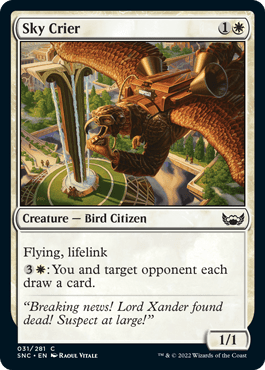
Rating: 3/10
While a 2-mana Healer's Hawk isn’t too bad, that card was printed in a set that could very easily buff it thanks to mentor. This set doesn’t seem like it can do it that easily, though it’s also a citizen which is turning out to be a very relevant creature type.
I’d just advise you to never activate Sky Crier’s ability. It’s just not something you can expect to work out well for you in a game of Limited.
Speakeasy Server
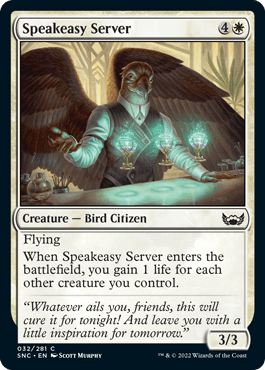
Rating: 5/10
5-mana 3/3 fliers with a little upside have usually performed well, and gaining what’s likely to be a decent chunk of life is definitely a worthwhile upside. You can’t play too many Speakeasy Servers but you’ll be very happy with the first one.
Swooping Protector
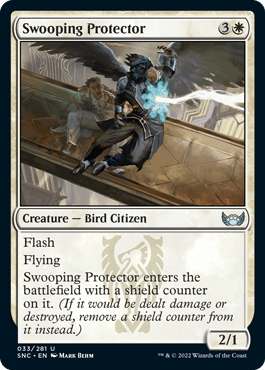
Rating: 4/10
I like the ability to flash in and eat a 2-toughness creature, but with only two power Swooping Protector isn’t likely to do much else with it. While it needs a bit of setup to be good I do tend to like tricksy cards like this, and being a citizen also opens a few doors. This will probably end up being better than it looks to me.
Blue
All-Seeing Arbiter
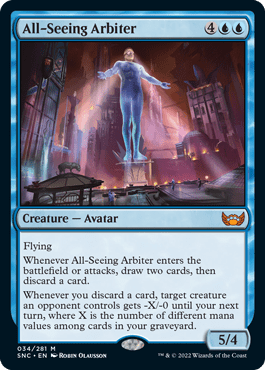
Rating: 9/10
Draw two and discard one is a pretty absurd trigger to get on entering the battlefield. Sticking All-Seeing Arbiter on a 6-mana 5/4 flier and having it trigger again when it attacks is just incredible. The final ability triggers when it attacks too which makes this a very difficult creature to deal with in combat. Even if it’s vulnerable to most removal it will still have entered and given you one trigger to refill your hand a bit, so you won’t have completely lost out.
Backstreet Bruiser
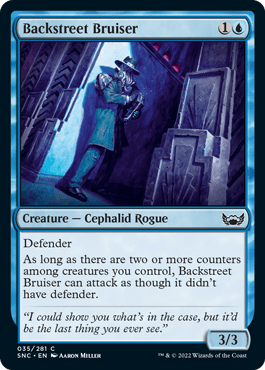
Rating: 5/10
I love me some 3/3 defenders for two mana. Backstreet Bruiser should be great for gumming up the ground and protecting you against early aggression. It can attack later, but I just want it to block for me as much as possible.
Brokers Veteran

Rating: 3/10
While Brokers Veteran is a good creature to play early and trade off for a good amount of value, its value drops really sharply as you move to the late game since it becomes harder to trade off and easier for your opponent to just ignore.
Case the Joint

Rating: 3/10
While I love drawing cards I think we can naturally do a bit better than Inspiration with the most minor of upsides. There are decks that want Case the Joint but it’s not high on their list of priorities.
Cut Your Losses

Rating: 1/10
The key to how to play Cut Your Losses is in its name. You should cut your losses and run before playing it. Unless you can back this up with other mill effects it just isn’t a viable way to win the game.
Let’s say your opponent has 20 cards in their library. Even if you casualty this, that’s only going to put them to five, giving them another five turns to win the game, a feat that’s much easier now that you sacrificed a decent creature and spent your turn adding nothing to the board. I’m not saying there are absolutely no situations for this card, but it’s not something that you should try without the right context. And it’s a tough sell even then.
Disdainful Stroke
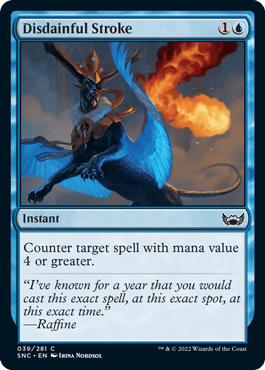
Rating: 4/10
We’ve seen Disdainful Stroke many times before and it’s always been a solid playable. It’ll always be trading up on mana with whatever it counters at two mana, and it’ll always be countering spells that you wanted to counter anyway, like bombs and big creatures. I’m not sure if it’ll be a priority to pick up but I definitely want at least one in all of my blue decks.
Echo Inspector
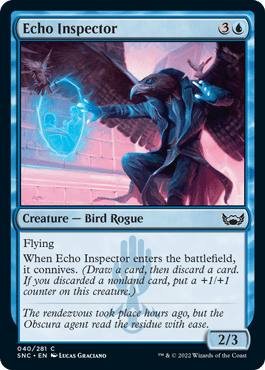
Rating: 4/10
Echo Inspector is another bog-standard common for connive, and one that offers you a very important choice. While a 2/3 flier for four mana is remarkably average, a 3/4 flier for four is a great deal, so discarding a weak spell to accomplish that is really enticing. Either way this is a fine deal for a common flier and one that I expect to fill out a few mana curves.
Errant, Street Artist
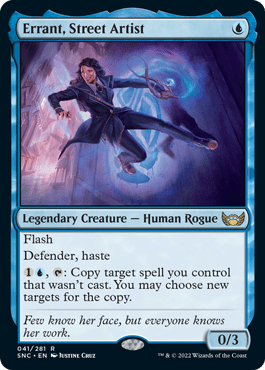
Rating: 6/10
Errant, Street Artist is a really cool card design and it looks like a really powerful build-around. It’s basically saying that you can use this ability to get an extra copy of a casualty spell in the context of this set. So once you sacrifice a creature to casualty you can pay two mana and get a third copy of that spell. You can also cast this as late as possible alongside the casualty spell or drop it on a turn where you have one mana to spare thanks to haste.
While I like the overall card, it’s quite niche and it’s hard to tell just how much value you can get off this in one game. But I like where it’s going and I’m excited to try it out for myself.
Even the Score
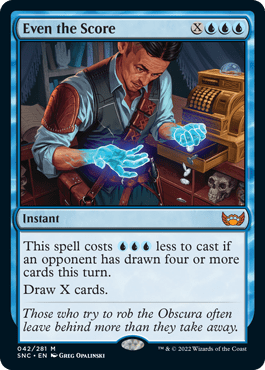
Rating: 4/10
Blue Sun's Zenith is a powerful card. You’re not very likely to get the cost reduction, but you could do worse as far as big draw spells go. Only the slowest decks and the best mana acceleration decks actually want Even the Score, but it should be a good “win condition” for those decks in that drawing about seven cards is often enough to win you a game.
Expendable Lackey

Rating: 5/10
These Fish tokens are going to be very powerful. And while a 1-mana 1/1 is going to be very ineffective, what Expendable Lackey does nicely is get itself discarded to a connive ability for some value and then turn itself into an unblockable 1/1. It can even be cast to be sacrificed to a casualty cost. Either way this is a great deal for a 1-mana common.
Faerie Vandal
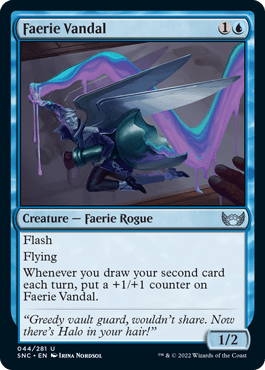
Rating: 7/10
We last saw Faerie Vandal in Throne of Eldraine where it was an exceptionally powerful uncommon. It’s not that hard to draw a second card in a turn, especially with connive in the set. And all you need is one trigger for this to be an absurdly efficient threat. This will become very large very fast if left unchecked and is a great build-around for the connive decks.
Hypnotic Grifter

Rating: 7/10
A repeatable looter that costs mana instead of tapping seems like a good deal. It’s even a cost you can pay on the turn you play it because of that. While a small looter like Hypnotic Grifter normally does nothing to the board, connive might end up growing it over time and making it into a viable threat. Connive decks will want to do it as often as possible but aren’t that likely to find repeatable ways to do it, making this a high priority for those decks and a great enabler for them.
Ledger Shredder

Rating: 6/10
Sometimes you won’t even need to enable Ledger Shredder yourself thanks to triggering whenever any player casts their second spell. Double-spelling is a powerful weapon in Limited and something that you should always try to find opportunities to do, so triggering this should be extremely easy. It might even dissuade your opponent from doing it at the same time.
A Little Chat
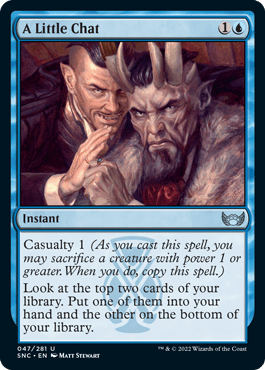
Rating: 5/10
A Little Chat is likely one of the better casualty spells. Its flexibility is incredible with casualty 1 and being an instant. Even without a dedicated deck for it, you can cast this and sacrifice a creature that’s about to be destroyed to get a bunch of extra value. And each copy gives you really good card selection.
Majestic Metamorphosis

Rating: 5/10
The key to Majestic Metamorphosis being playable is the fact that it draws a card. Blue is the color that’s least likely to want a combat trick, but a combat trick that nets you a 2-for-1 is always appealing. Like we saw with Suit Up in Neon Dynasty, this should be a very strong card that you’re happy to play in most decks.
Make Disappear

Quench is a fairly bad counterspell that gets outclassed a lot in the late game. Casualty goes some way towards stopping that, but if you’re spending Make Disappear plus a real creature to counter one spell, that spell had better be worth it.
While this isn’t unplayable I think it’s bad in enough scenarios to not be something you jump too often. Especially when Disdainful Stroke does a much better job of countering relevant spells.
Obscura Initiate

Rating: 4/10
Wind Drake hasn’t been hugely playable for a while, but the ability to gain lifelink is enough of a bonus to make Obscura Initiate good. Assuming it can reliably attack this should be a good early attacker, and the lifelink keeps it relevant through to the late game.
An Offer You Can’t Refuse

Rating: 1/10
As awesome as An Offer You Can't Refuse’s flavor is, it’s not a good card. You wouldn’t be in the mood to play Negate and this is substantially worse than that. It’s too situational for your Limited main decks and giving your opponent two Treasure tokens is enough of a drawback to put you off playing it in some situations where you would have been happy with Negate. It looks like it has some very real Constructed applications, but it’s bad for Limited.
Out of the Way
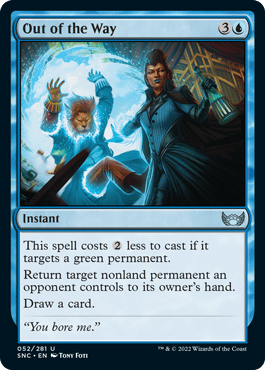
Rating: 5/10
The blue color hoser is a card that you’re very happy to play in your main decks even without the cost reduction. Out of the Way is essentially Leave in the Dust, a card which that very good even in a set as aggressive as Aether Revolt, so it should be even better in what’s likely to be a substantially slower format.
Psionic Snoop
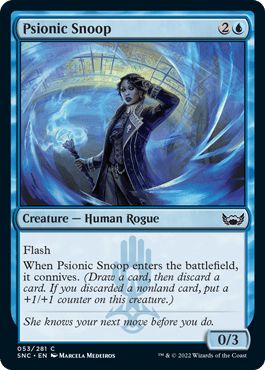
Rating: 2/10
Psionic Snoop confuses me. I’m not sure why you’d need this effect on a flash creature, and a really undersized one at that. Triggering draw or discard triggers at instant speed might be nice, but the raw stats on this are so low that you won’t be interested most of the time.
Psychic Pickpocket
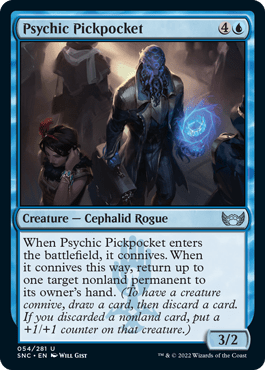
Rating: 7/10
Here’s your token Man-o'-War for the set, and a pretty good one at that. Not only can Psychic Pickpocket bounce any nonland permanent instead of just creatures, it also gives you a connive while you’re at it to dig deeper into the deck. Excellent card and you’ll want this in all your blue decks unless things go horribly wrong.
Public Enemy
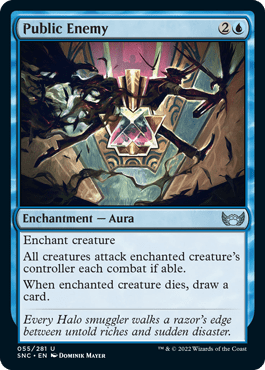
Rating: 5/10
Thanks, WotC, for giving me an entirely unique card effect that’s hard to evaluate. Public Enemy has me a little stumped and is probably the card I’m most likely to be wrong on.
How does it work? Well, you enchant your own creature and it forces your opponent to attack you every turn. This is great if you have bigger creatures and can essentially eat all of theirs. But on the other hand, attacking is something your opponent will do a lot anyway so the card is useless most of the time.
This card has the potential to be either massively game breaking, or completely unplayable. And the delta between those events is huge, making this quite the interesting card. I’m going to hedge my bets and say that it’ll end up being a decent card in the right deck, but I wouldn’t be surprised if it ends up being a last pick quality garbage card by July.
Reservoir Kraken

Rating: 7/10
We’ve seen a lot of variants of this type of big creature, and they’re pretty hit and miss. 1/1 unblockable Fish tokens are very powerful and the Fish will add up eventually and become threats by themselves if your opponent needs to be tapping Reservoir Kraken down. They can’t keep tapping it indefinitely, which makes this a very real must-kill threat. And that equals a good card in my view.
Rooftop Nuisance

Rating: 5/10
While we’re used to seeing Crippling Chill at instant speed and it’s very good at that, changing it to sorcery and giving it casualty 1 seems like a reasonable trade off. Rooftop Nuisance won’t be as versatile as its instant speed counterparts but it should still be fine. Not to mention that sacrificing a throwaway creature to draw two cards while stopping some creatures for a turn seems like a good deal.
Run Out of Town
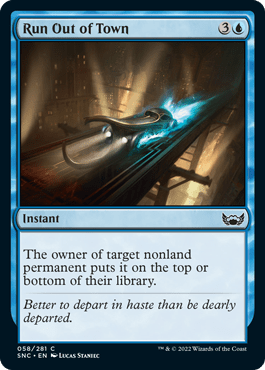
Rating: 4/10
You can do a lot worse for blue removal spells in Limited. Being an instant is great and opens up possibilities for 2-for-1s in combat and other such shenanigans. You can’t play too many Run Out of Towns and your 3-color decks are likely to have access to better options, but this isn’t bad by any means.
Security Bypass

Rating: 3/10
Security Bypass is efficient enough to make an impact and help you close out a game, but like all auras it’s open to all of the downsides that come with them. Namely that it opens you up to easy 2-for-1 plays by your opponent. You won’t want this all the time but it’s not too bad if you decide to go down this route.
Sewer Crocodile
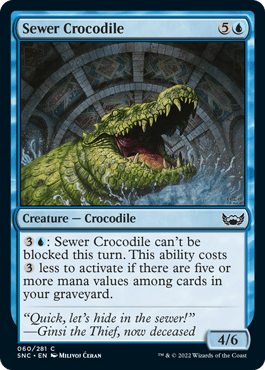
Rating: 3/10
They’ve tried to make the big expensive creature that can become unblockable for a lot of mana work over the past couple of years and it never has. I’m interested in being able to do it for one mana, so I’d maybe be interested in a deck that could reliably get that going. But with so many effects that make 1/1 unblockable tokens I’d rather go down that route than spend six mana on Sewer Crocodile.
Sleep with the Fishes
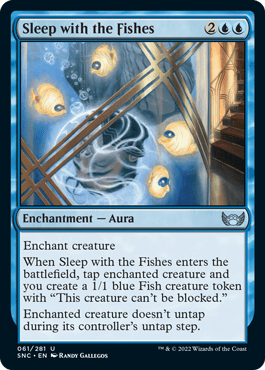
Rating: 6/10
Four mana is quite a lot to pay for a Claustrophobia without flash, but getting a powerful creature token out of the deal should be more than enough to reward you for the extra mana you’ve spent. These effects have been getting a lot worse recently so be wary of that, but like I say, getting an unblockable 1/1 out of the deal means you got something very real for your mana even if Sleep with the Fishes ends up being worse than you expected.
Slip Out the Back
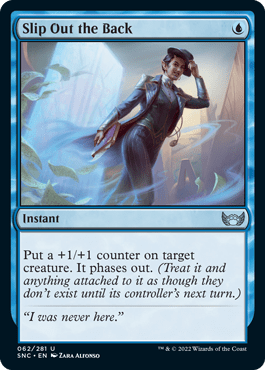
Rating: 5/10
I like Slip Out the Back quite a bit. If you can save a creature from removal for just one mana then that card is usually going to be worth playing. And giving the creature a +1/+1 counter is just icing on an already very appetizing cake.
Undercover Operative
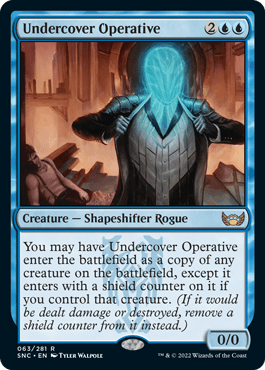
Rating: 8/10
Clones are always going to be powerful in Limited, especially if they can copy your opponent’s bomb rares. I like that Undercover Operative can do that and you get a nice bonus for copying one of your own things. But it’s worth noting that this will be hard to play on turn 4 and is more likely to be waiting until a few turns later at double blue for a casting cost. But it’s still going to be great then, so take this and be happy if you’re blue.
Wingshield Agent
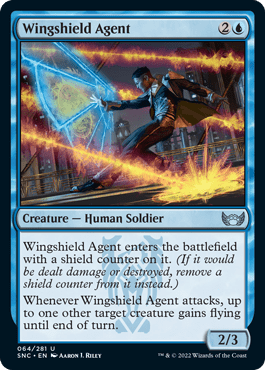
Rating: 4/10
I get that what Wingshield Agent is saying is that it can attack with impunity thanks to its shield counter to give something else flying, but I’m not really that into it. Pegasus Courser was a great card but it usually promised to be able to attack unimpeded multiple times while this card can only reliably do it once. That said, a 2/3 with a shield counter is still a good rate for three mana so it’s not a horrible card. I just doing think it’s effective at doing what it’s designed to do.
Wiretapping
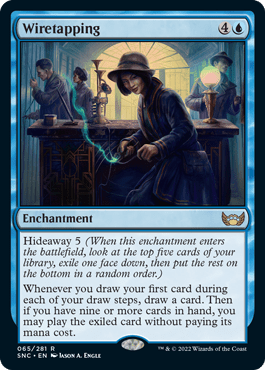
Rating: 6/10
Getting to nine cards in hand is just not realistic with the way that most Limited decks play out, so I’m just rating Wiretapping as a 5-mana enchantment that draws you a card every turn. That’s still pretty good and something that slow Limited decks really like to see.
Witness Protection

Rating: 1/10
You can take Witness Protection (Kasmina's Transmutation, Ravenform, etc.) and make it look as cool as you like, but it’s still a terrible card and not something you should put in your deck. Turning a big bomb into a 1/1 with no abilities is just not a good thing to spend even one mana doing. Your opponent can always get rid of the enchantment and the 1/1 left behind is still a relevant card on the board. Just avoid this.
Black
Angel of Suffering
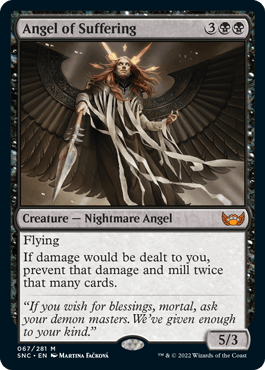
Rating: 7/10
While it sounds good to prevent all damage dealt to you, this isn’t always going to be a blessing. You only have 40-card decks to play with in Limited and by the time you play Angel of Suffering it’ll be more like 20 to 25 cards, so milling you for double the damage might end up killing you faster than just taking it.
That said, you do get a pretty big flier that can trade off if you need it to and black has a lot of ways to sacrifice it if you’re running low, so maybe you can control the chaos that this incites. There are a lot of cards in black that care about the graveyard too, so this can enable some of those synergies while you protect your life total.
There’s a lot to like here so I think this will end up being pretty strong, but beware of how quickly your deck will end up getting milled.
Body Launderer
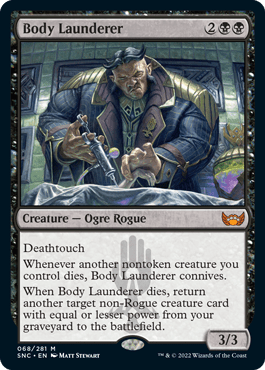
Rating: 8/10
Body Launderer looks remarkably fair for a mythic. It’s giving you a nice trigger whenever you sacrifice a creature, something that a lot of decks want to do, and also replaces itself when you eventually sacrifice or trade it off later.
Starting out as a Hill Giant is a little on the small side, but deathtouch helps to make up for that a little bit. You’re never going to be all that unhappy to have this in play and it definitely provides you with a good amount of advantage over multiple turns.
Cemetery Tampering

Rating: 4/10
If you really need to be self-milling then Cemetery Tampering is a good way of doing it. You can control the amount of milling so you won’t deck yourself, and the hideaway ability has a fairly reasonable condition to give you a free spell later. The problem is that this card is just not good unless you actively want to mill yourself a lot. Find the right deck and you’ll be onto a winner.
Corrupt Court Official
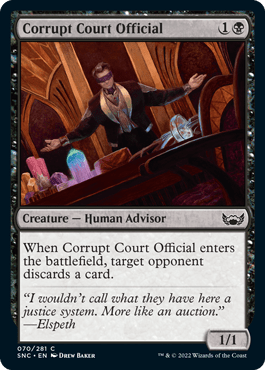
Rating: 5/10
Like Virus Beetle in the last set and other similar cards before it, Corrupt Court Official is a powerful card that gives you immediate value if you play it early. It’s then great to be sacrificed or whatever else you need it for. Great card and a very solid common.
Crooked Custodian
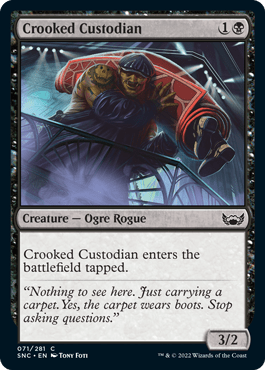
Rating: 3/10
Entering the battlefield tapped is a very real downside that’ll just make Crooked Custodian worse than a vanilla 2/2 would be on average. Having three power is definitely relevant for casualty, but you don’t want to spend a whole card just to get better fodder. You’d rather sacrifice creatures you got for free in some way. This is a fine 2-drop but really nothing that exciting.
Cut of the Profits
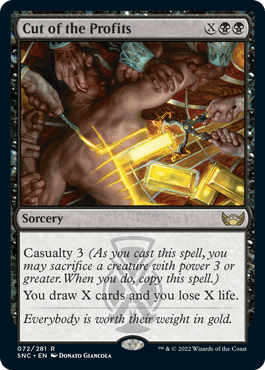
Rating: 7/10
X draw spells are powerful weapons in Limited and Cut of the Profits is a very efficient version of it. With the life loss factored in you really have to be careful about how high you go with this. The most likely sweet spot for this is to cast it for three or four cards and then sacrificing a creature to double that if you can afford the life loss to give you a fresh hand to get going with. While you should treat your life total as a resource it’s a much more scarce resource than in most Constructed formats, so just make sure you can afford to pay the costs you need.
Cutthroat Contender
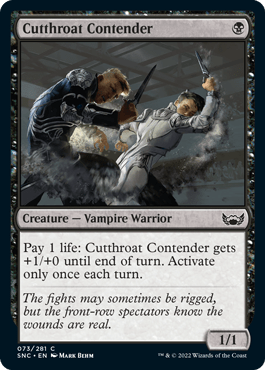
Rating: 2/10
I don’t get it. Cutthroat Contender is basically a 1-drop 2/1 but you have to pay life whenever you want it to be that? It’s not like you can attack into a 2/2, they don’t block and then you’re happy for them to just take one damage, that’s not enough to apply pressure or make them worry. You need to pay the one life to actually do that. This is probably just bad, so I wouldn’t bother with it until something else changes my mind.
Deal Gone Bad
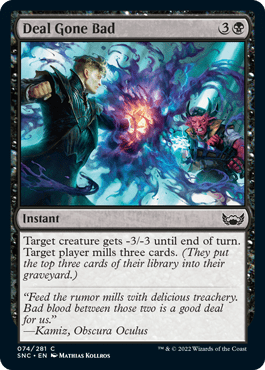
Rating: 5/10
Deal Gone Bad is really overcosted for what you’re getting out of it, but removal is removal. At the end of the day this isn’t exciting but it does what it’s supposed to do. At least it’s an instant so it can also be used as a nice combat trick to take down bigger creatures.
Demon’s Due
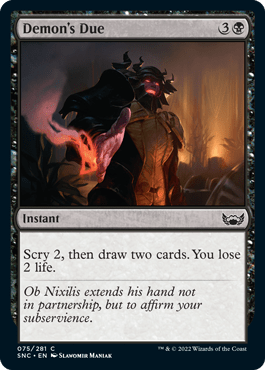
Rating: 4/10
Instant speed Read the Bones is still a pretty good card. We’ve seen similar variants to Demon's Due with cards like Bitter Revelation, and they’ve usually found a home in the format. The slower your deck is, the better this becomes.
Dig Up the Body

Rating: 4/10
Your deck can never play too many of this kind of effect, but Dig Up the Body is a great effect to trade in a creature for an extra go of. You basically end up swapping your creature on board to get one back from the graveyard.
As an instant, doing this in response to a removal spell or something similar will turn this into a very easy blowout really quickly. You can probably only play one copy of this in most decks but I think you’ll be very happy to find that one copy.
Dusk Mangler
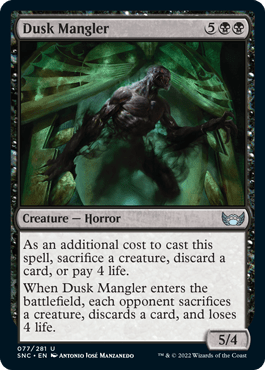
Rating: 5/10
Dusk Mangler reminds me a lot of Goremand, a card that worked really well with the set’s reanimation theme for Dimir. Reanimating or flickering this is a great way to really get some value from it, but having to cast it isn’t the worst thing in the world. It does have a big impact on the board and can lead to big blowouts in some situations.
Extract Truth
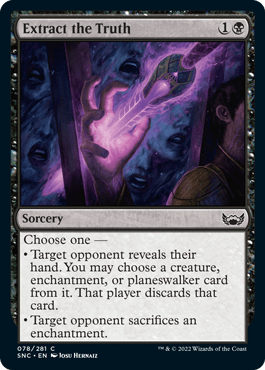
Rating: 2/10
Like most Coercion effects, Extract Truth isn’t something you typically want in your main deck. Given the extra mode it’s a very relevant sideboard card, but it should be left there until needed.
Fake Your Own Death

Rating: 3/10
Effects like this either over or underperform. Fake Your Own Death looks on the better side and is extremely flavorful, but you still can’t play too many of them and can probably find one in a Draft if you really wanted it.
Girder Goons
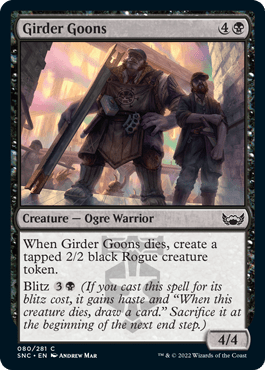
Rating: 4/10
Girder Goons seems like a good deal whichever way you cast it. Either you have a 4/4 dying into a 2/2 or you blitz it and get an attack for four, a 2/2, and an extra card. It’s on the expensive side but this is definitely going to be a fine play regardless of how you choose to do it.
Graveyard Shift

Rating: 4/10
Reanimation spells are very hit or miss in Limited. This set does have a considerable amount of self-mill and graveyard shenanigans, so Graveyard Shift isn’t unreasonable. Giving it flash is also pretty nice since your new creature can ambush an attacker. You still need a few things to go right for this but I imagine there will be a few decks that are very happy to pick this up.
Grisly Sigil

Rating: 6/10
I really like the design of Grisly Sigil and it screams flexibility to me. On its surface it’s just dealing one damage to a creature and gaining you one back, but you deal four to the same creature and gain four back if you can pay its casualty cost.
But what if you add in some other effects? What if you already dealt noncombat damage in the same turn? Now you have a scenario where you could casualty this and kill two creatures with it. And you could already do that to kill off 1-toughness creatures. All of these modes on a 1-mana spell looks great to me.
Illicit Shipment
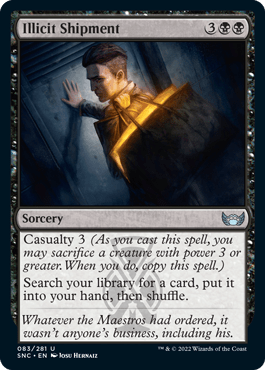
Rating: 0/10
Just no. Diabolic Tutor isn’t a playable Limited card, let alone one that costs five mana. Casualty is at least worth considering on Illicit Shipment but having to sacrifice a creature of three power or greater sounds like too high a cost for not enough of a gain.
Incriminate
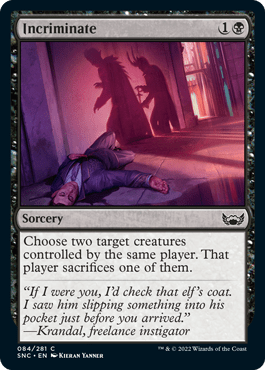
Rating: 4/10
You have to set Incriminate up a little bit, but you’re probably going to get something good out of it unlike other edict effects. This basically kills their second best one against a board full of creatures, which is a lot more than Diabolic Edict or Cruel Edict are capable of doing.
You can’t play too many of these but they should be solid as you move towards the late game. It’s just a shame that they’ll never kill the creature you really want to.
Join the Maestros

Rating: 1/10
Five mana for a 4/3 creature token is a terrible deal. The casualty cost doesn’t improve Join the Maestros much because all it does is “upgrade” one of your creatures into a 4/3. I’d say this is never likely to be a good deal and you should just not bother. You can find better 5-drops and most 4-drops are in fact better than this.
Maestros Initiate

Rating: 4/10
Maestros Initiate looks like an incredibly solid curve filler common. While a 3/1 trades down for 1/1 creatures a little too often for my tastes, it can be sacrificed to any casualty card in the set and then gives you a great graveyard activation later.
Midnight Assassin

Rating: 3/10
As much as I like cheap deathtouch creatures, three mana is a little too much to pay, even if it does fly. I’m sure Midnight Assassin will end up being fine when you play it but you can probably find better cards.
Murder

Rating: 8/10
The quintessential black removal is back, and of course it’s thematic to the crime themes of the set. It’s hard to remember a time when Murder wasn’t just the best black common/uncommon in a given set, or at least in the top five. It is a solid card in Streets of New Capenna.
Granted, double black is going to be a lot harder to get to in this set compared to a normal set, but casting this on turn 10 versus turn 3 is absolutely fine. This is pretty much always a good draw and you should still want to play as many of these as you can get your hands on.
Night Clubber
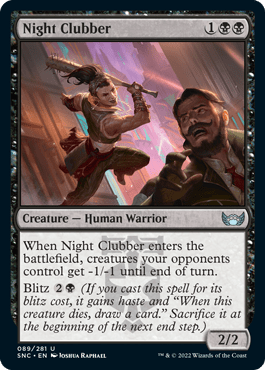
Rating: 7/10
There are going to be some great situations where Night Clubber kills a creature on entering the battlefield and possibly even more. This is going to be just brutal against the Selesnya citizens decks and the 1/1 unblockable Fish tokens. That covers enough decks in the format that you want to prioritize this during the Draft, and it stands to be one of the strongest cards in your list when you get paired against those decks.
Raffine’s Silencer
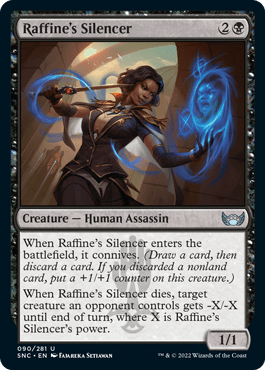
Rating: 5/10
Raffine's Silencer is still a 1/1 that trades up for 2/2s having given you an extra card, even if you don’t get the +1/+1 counter from connive, and that seems like a great deal to me. Throw in any ways to buff it including the connive ability and you start getting to a creature that can trade for two rather than just one. That potential makes this a great card, albeit one that you have to put a little work into.
Revel Ruiner
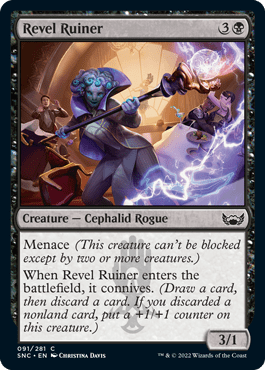
Rating: 3/10
The typical 4-mana menace creature that we see in a lot of sets is still not very exciting even when you strap on a connive ability. But Revel Ruiner isn’t the worst card in the world if you want something to fill out your curve.
Rogues’ Gallery
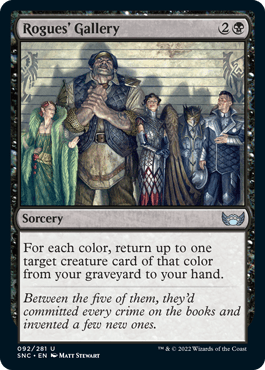
Rating: 6/10
Rogues' Gallery looks excellent to me. If you’re only a 2-color deck then this is only going to be a Soul Salvage, but that’s pretty great already. A lot of decks in the format will in fact be three colors or more which means that you can get often back three to five creatures with this, and that’ll really feel like you’re getting away with something.
Sanguine Spy
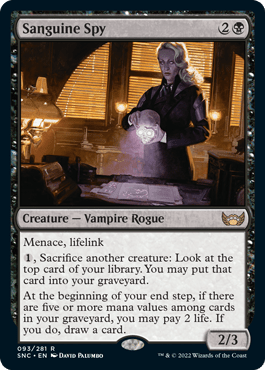
Rating: 6/10
A 2/3 menace lifelinker is already a fine deal. Letting you sacrifice creatures to surveil, particularly ones that you’ve blitzed, is also a very nice ability to have. But what I’m really looking at is the final ability.
If you can reliably get to five mana values in your graveyard then Sanguine Spy is going to be one of the biggest payoffs for that archetype. In fact this gives you a very real reason to try to make that strategy work, and that’s exactly what I like to see in a build-around card.
Shadow of Mortality
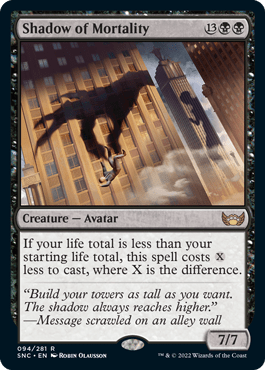
Rating: 6/10
Of course the easiest comparison to make here is to Death's Shadow. The name is even remarkably similar. Is Shadow of Mortality good in Limited? Probably. It’s only a vanilla 7/7, so how much mana are you happy to pay for that?
I’d say if this can cost five or less then you’re pretty happy with that deal, and you only need to be at 10 life to do that. A 7/7 is going to be reasonably hard to deal with and probably the biggest creature on the board, which is a pretty decent way to help to catch you up when you fall behind.
Sadly it’s wildly uncastable if you’re winning and haven’t taken much damage yet, but I think that’s a fair compromise given how good it’s going to be at other times.
Shakedown Heavy
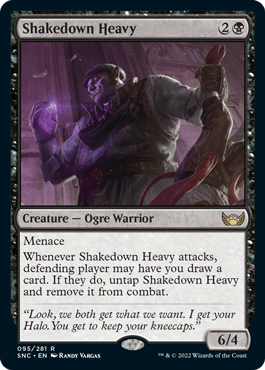
Rating: 8/10
The downside with “punisher” mechanics that let your opponent choose what happens to them is always that they can just choose the mode of your card that’s best for them. But taking a hit from a 6/4 menace and you drawing a card will (for the most part) be extremely bad for them either way.
They’re probably happy for you to attack into a pair of 2/2 creatures to trade off but you only spent three mana on Shakedown Heavy in the first place, so you’re doing pretty well even if you trade it off. This is also a great way to spend your removal since it forces double blocks and your opponent is heavily incentivized to make them, making your instant speed removal and combat tricks much more useful.
Tavern Swindler
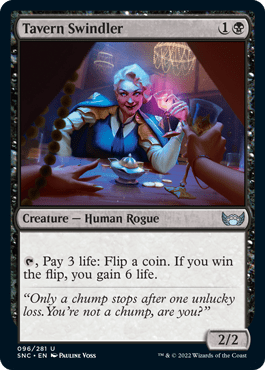
Rating: 2/10
Tavern Swindler is a fun reprint for flavor purposes but it’s pretty bad otherwise. Simple probability will tell you that you won’t gain or lose any life with this on average over the course of several coin flips, which essentially makes it a 2/2 vanilla with no upside.
There isn’t even a lifegain archetype for this to work with, so most of the time you just don’t want this and can do much better.
Tenacious Underdog
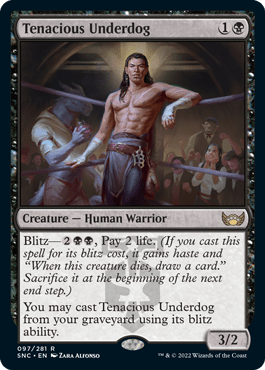
Rating: 9/10
Tenacious Underdog seems utterly bonkers to me. Just like the escape mechanic from Theros: Beyond Death, this card doesn’t get exiled after being cast from the graveyard, meaning you can just do it over and over again.
Even if a 3/2 is bad on the board you still get to draw a card thanks to the text on blitz, so this is never a bad late game play. You just get to sit back and enjoy the value train pulling up each and every turn whenever you need it to.
Vampire Scrivener

Rating: 3/10
Without an actual lifegain theme Vampire Scrivener looks a lot weaker than it could be in a different set. Which begs the question, what is it doing here? I guess if you want to combine it with Tavern Swindler then you’ve got a fun engine on your hands, but it’s not going to be a good card unless you specifically build around this.
Whack

Rating: 6/10
While not an instant, Flatten is still a good rate for a removal spell and will still be great in whatever deck you have. You don’t need Whack to target white creatures to be playable. That cost reduction is just a nice bonus if it lines up.
Red
Antagonize
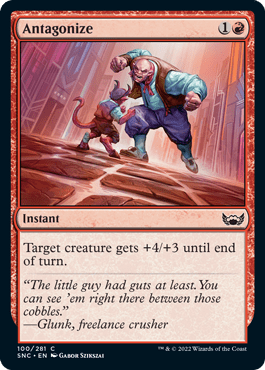
Rating: 2/10
Infuriate was never all that good at one mana, so Antagonize being marginally stronger for a whole extra mana doesn’t inspire me much. You could do worse if you need a combat trick, but this is still below the rate I’d be looking for.
Arcane Bombardment
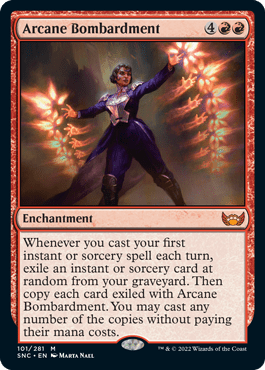
Rating: 2/10
Arcane Bombardment looks like a powerful build-around that won’t have enough fuel to set up. Casualty does mean that the Maestros should have a good number of instants and sorceries in their deck, but you need a lot of impactful ones for this card to end up working for you. Probably a sweet card for Constructed and very reminiscent of Eye of the Storm, but not something I’m too interested in here.
Big Score

Rating: 5/10
Unexpected Windfall was a good card back in the Forgotten Realms format and has been a solid card in Standard too. Big Score is a strict upgrade with an easier mana cost to fulfill. I expect it to be just as good here, maybe even better thanks to the Gruul Treasures archetype.
Call In a Professional

Rating: 6/10
You can ignore the Skullcrack text on Call In a Professional for the most part and just treat it as an Open Fire, which is still a great card and something you actively want in all your red decks.
Daring Escape
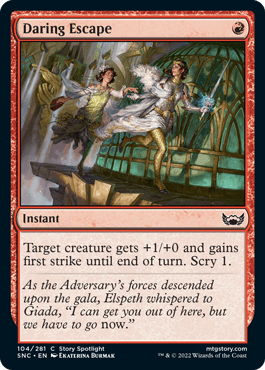
Rating: 3/10
Kindled Fury is a fine combat trick, though not one I’ve ever liked much. Adding on scry 1 does make a big difference since winning a combat plus securing your next draw step adds up to a good deal if you’re in the market for Daring Escape’s effect.
Devilish Valet

Rating: 5/10
There are some incredibly dirty plays you can make with Devilish Valet. It reminds me a lot of Electrostatic Pummeler, which ended up being a fun build-around for both Limited and Constructed.
The use case for this is that you’ll have played zero, one, or two creatures on your turn, which makes this is either a one, two, or four power trample haste. That’s not terribly exciting, especially as the most common of those is probably going to leave it as a 1/3. It has some potential if you have some ways to make multiple tokens and have this grow to a 16- or 32-power creature, but it’s probably too weak outside of that.
Exhibition Magician
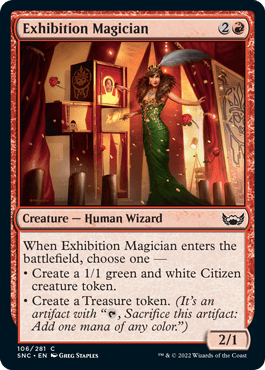
Rating: 5/10
Three mana for a 3/2 spread across two creatures is always going to be a great deal, especially with all of the alliance triggers that Exhibition Magician works with. I don’t think you’re as likely to want the Treasure token but having the option to cast a 5-drop on turn 4 is just pure upside.
Glittering Stockpile

Rating: 3/10
Mana rocks aren’t the most playable in Limited these days since ramping from three mana to five doesn’t accomplish enough to warrant using a whole card. While Glittering Stockpile is a Treasure and is therefore good for the Treasures-matter cards in red and green, I doubt you need to spend a whole card to do this. But it still has some potential and this card’s stock goes way up if that archetype is good.
Goldhound

Rating: 4/10
Goldhound doesn’t look very exciting at all as a simple 1-drop with first strike and menace. But being a Treasure makes a fairly big difference. Giving you a bigger creature ahead of schedule and working with all of the set’s Treasure synergies are probably enough to care about this.
Hoard Hauler
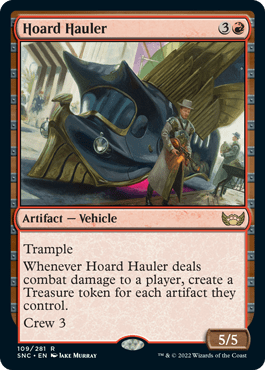
Rating: 5/10
Other than Treasures there are no artifact-based archetypes in this format, so Hoard Hauler’s value really hinges on how much you want a Vehicle with these raw stats. A 5/5 trample for four is very reasonable, but crew 3 is a bit hard to do. I can see this being a reasonable card in an aggressive deck but it doesn’t do much more beyond that.
Involuntary Employment
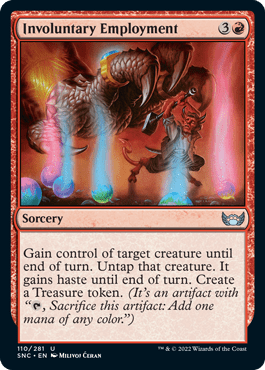
Rating: 6/10
Normally your average Threaten effect is fine since you can find ways to sacrifice the creature you steal. Involuntary Employment has got to be powerful given how the Riveteers look to sacrifice everything.
Price of Loyalty ended up being the best common in Forgotten Realms thanks to how easy it was to find ways to sacrifice your stolen creature. I expect this to be just as good in New Capenna.
Jackhammer

Rating: 1/10
Both the casting cost and equip cost are a bit too expensive for a very minimal equipment. Jackhammer is just not going to do enough for you to want to spend a whole card doing it, so I’d just ignore it and move on.
Jaxis, the Troublemaker

Rating: 8/10
Jaxis, the Troublemaker is a curious card that really should do a good job of turning leftover cards into very real card advantage at the end of the game. While you only keep the creatures it makes for the one turn they do get blitzed and turn into cards at the end of the turn.
If you get this going with a good ETB or dies trigger then it goes from a seemingly innocent creature into a must-kill threat, and that equals a pretty good bomb rare in my opinion. Its own blitz cost also means that you could effectively just cycle it for two mana if you really had to, meaning it’s never a dead draw.
Light ‘Em Up
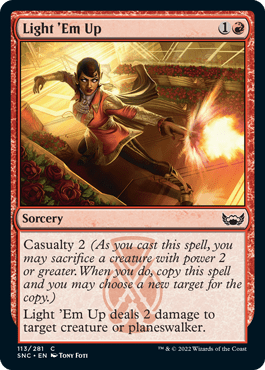
Rating: 5/10
Sorcery-speed Shock for two mana is quite a bit weaker than you really want it to be. Scorchmark ended up being a very weak spell back in Ravnica Allegiance for this very reason.
I think the casualty cost provides you with enough flexibility that Light ‘Em Up is worth using, but having to sacrifice a very real creature may be too much of a hindrance. But you do have blitz creatures that you really want to sacrifice for value so it shouldn’t be too hard to find something that you won’t miss once it's gone.
Mayhem Patrol
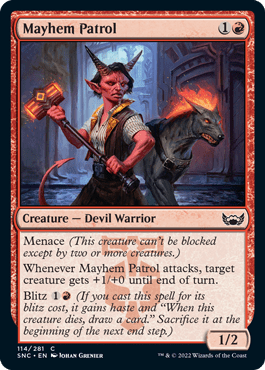
Rating: 4/10
I’m not particularly thrilled with Mayhem Patrol as a common 2-drop creature. A 1/2 menace creature isn’t at all threatening so it likely wants to buff itself with its trigger a lot of the time.
But I’m very interested in its cheap blitz cost making it the ideal creature to be blitzing and then sacrificing to a casualty cost for a bunch of value. This a good common enabler for those decks.
Plasma Jockey
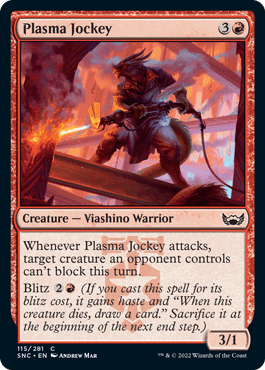
Rating: 5/10
Plasma Jockey reminds me a lot of Ahn-Crop Crasher, a card that ended up as maybe the best nonrare card in Amonkhet. This isn’t anywhere near the same kind of power level but it’s very useful in an aggressive deck and the blitz cost lets it come out of nowhere to give you a favorable alpha strike. Having three power also means it’s good to blitz in and sacrifice to any casualty spell, and that’s also something that certain decks are going to want.
Professional Face-Breaker
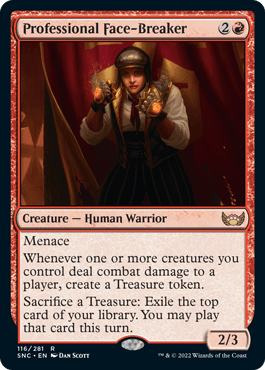
Rating: 8/10
Treasure tokens only give you mana, making their usefulness to you very limited in scope. Turning them into real cards like Professional Face-Breaker does is extremely valuable.
This could net you a lot of cards drawn if you play it right and that’s really all you should need to win a game. It even gives you a built-in way to get more Treasures and that whole package is one I’m very interested in, even if my deck doesn’t have a lot of Treasures in the first place.
Pugnacious Pugilist
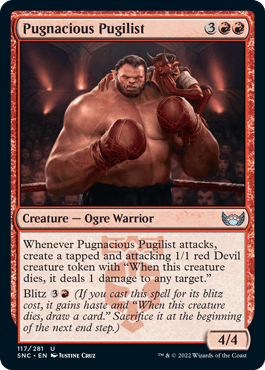
Rating: 7/10
These Devil tokens that we’ve seen from previous sets like Shadows Over Innistrad are extremely valuable, especially in a set with such a heavy focus on sacrificing creatures. If you run Pugnacious Pugilist out for five mana it’s a must-kill threat since your opponent runs the risk of being buried in card advantage from the little Devils it creates.
If you just blitz it for a one-shot then it’s still very good seeing as you still get a Devil token and your card back when the Pugilist dies. No matter how you look at it you have an impactful play. The only downside is that the Devils are forced to attack, so there will be times when your opponent has only good blocks and you don’t gain much. But if you have any ways to sacrifice them at instant speed then it’s still something you’re happy to do.
Pyre-Sledge Arsonist
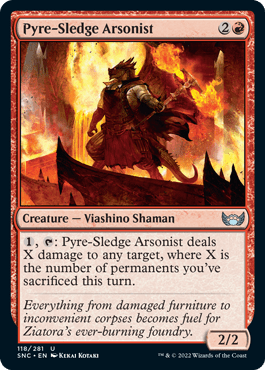
Rating: 7/10
A build-around for the sacrifices archetypes that lets you kill off creatures is absolutely huge. These are typically some of the strongest Limited cards in the game. Pyre-Sledge Arsonist should be a very high draft pick for you if you’re deep into this archetype.
The only reason this doesn’t get a higher grade is because it doesn’t do anything if you haven’t sacrificed anything, meaning it only really fits in a really dedicated deck. But on the plus side that should mean that it should get passed around if one is opened in your draft and you want it.
Ready to Rumble
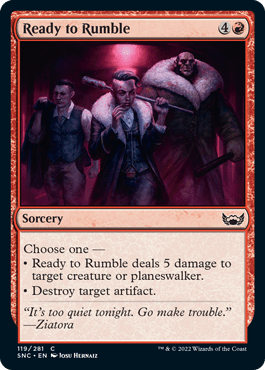
Rating: 4/10
Fiery Intervention was a decent removal spell in Dominaria and this typical 5-mana big damage spell usually lands on the playable end in most sets, but you don’t want too many Ready to Rumbles. The first one is very valuable while the extra copies lose their luster.
Riveteers Initiate

Rating: 4/10
We all like a decent 2-drop that scales well into the late game. Having the ability to apply pressure on turn 2 and trade for big creatures on turn 6 makes Riveteers Initiate a fine creature for any deck that can use it.
Riveteers Requisitioner
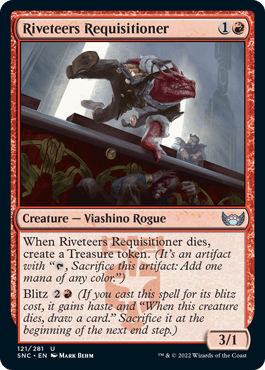
Rating: 6/10
Riveteers Requisitioner is another great blitz card that you’re going to be pretty happy with whichever way you cast it. Either you have a nice aggressive 2-drop or later on you blitz it to get a card back, a Treasure, and a free thing to sacrifice. Both of those are good options so this card looks pretty good to me.
Rob the Archives
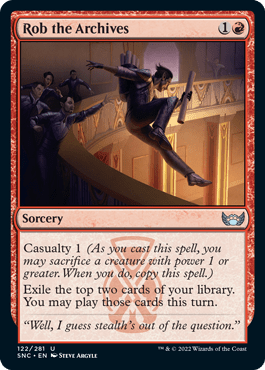
Rating: 3/10
Reckless Impulse was a pretty great card in Crimson Vow, but it afforded you the ability to play the exiled cards until the end of your next turn. There are far fewer applications when you have to play your cards on the same turn as casting Rob the Archives.
Using the casualty cost really just lets you see more cards to pick from since you’ll probably only be able to play a land and cast one spell. I just think this card is a little too restrictive to be as good as you want it to be so I’d probably just avoid it.
Sizzling Soloist

Rating: 6/10
If you’re making lots of creatures each turn then Sizzling Soloist essentially makes your entire team unblockable. Forcing one of your opponent’s creatures to attack you next turn also lets you eat smaller creatures or just get it tapped so you don’t have to worry about targeting it again the next turn.
While this card is extremely weak when you don’t have creatures, that should be balanced out by the times when you have several and this effect is powerful enough to really swing a race in your favor.
Sticky Fingers
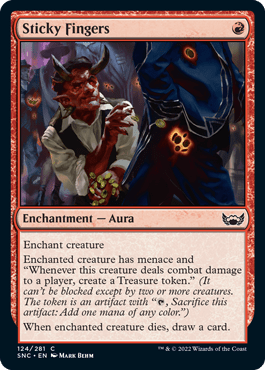
Rating: 2/10
I just don’t like auras like Sticky Fingers. It’s doing a lot of things while not actually accomplishing much. It does have an ability to help mitigate you getting blown out by a 2-for-1, but it doesn’t stop you getting wrecked by a bounce spell, an exile spell, or anything else.
I wouldn’t bother with this but I know a lot of players will try it.
Strangle
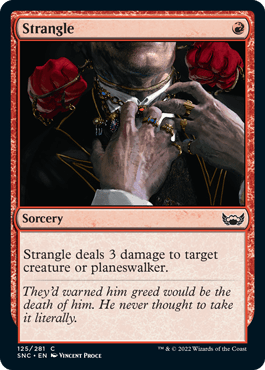
Rating: 6/10
You love to see a nice cheap removal spell. It’s not an instant so Strangle’s applications are a little more limited than you’d like, but it’s still three damage for just one mana and that’s a very valuable card for any red deck.
Structural Assault
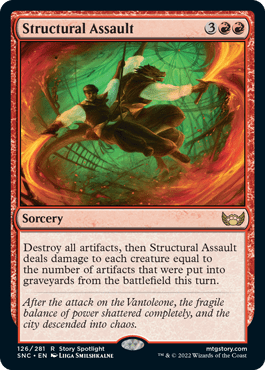
Rating: 4/10
In a set that doesn’t have an artifact theme the Shatterstorm mode on Structural Assault is obviously irrelevant for the most part. But what this actually is is a nice payoff for a Treasure deck.
If you have a bunch of Treasures in play you can sacrifice them all for mana and then cast this to sweep the board for a load of damage. This doesn’t even need to destroy the Treasures itself since it still counts them and deals damage based on that number as long as you sacrificed them earlier in the turn.
If you can reliably get this to about four or five damage then it’s just a good board sweeper. And you never know, you might take one or two artifacts down with you.
Torch Breath

Rating: 5/10
Instant-speed Blaze is still a very fine removal spell that scales with the game to kill pretty much any creature. You’ll be pretty happy with Torch Breath’s cost reduction if you get it, but I’d be happy to play this against any color combination.
Unlucky Witness

Rating: 5/10
Unlucky Witness is a pretty nice bit of sacrifice fodder for the decks that want that. If you sacrifice it on your opponent’s turn or chump block with it then you get to untap all of your mana to play whatever card you want to from what it shows you, which is pretty useful.
It isn’t very strong if it isn’t being sacrificed so you really want to be in that deck before you pick this up. But it should be pretty decent for you when you do.
Urabrask, Heretic Praetor

Rating: 9/10
The latest of the Phyrexian Praetors to grace us with their presence is a real doozy. Urabrask, Heretic Praetor is simple enough, a 5-mana 4/4 haste that lets you draw an extra card each turn. I quite like that.
The symmetrical ability to force your opponent to play every card they draw for their turn isn’t that punishing so I’m not really taking it into account here. Urabrask should be able to hit hard enough and provide you with enough card advantage on sequential turns to win you the game when you play it, but it may take a little while to see the benefits.
Widespread Thieving
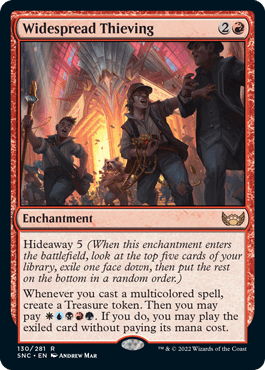
Rating: 2/10
I really don’t like this hideaway spell. While the other enchantments in this cycle let you cast the card you found with hideaway for free, Widespread Thieving doesn’t. You need to have cast a multicolored spell and then it lets you cast the hidden card for one mana of each color.
That’s just not that good of a deal for most cards that you could find. After all, you spend three mana on this enchantment in the first place and only giving you a Treasure token when you cast a multicolored spell isn’t enough of an upside from a 3-mana enchantment.
While the other cards in this cycle feel like you’re getting a good amount of value from the enchantment and eventually a free spell, this doesn’t feel like you’re getting much of anything at all. And you don’t even get the hidden card for free. Yeah, I’m not a fan.
Witty Roastmaster
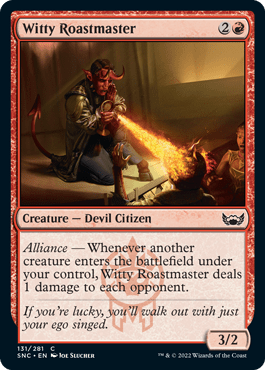
Rating: 5/10
Now Witty Roastmaster is a nice alliance payoff. It’s great that it’s providing a steady stream of damage for just doing what you wanted to do in the first place, and it’s hardly an embarrassingly sized creature as a 3/2 for three mana.
Wrecking Crew

Rating: 3/10
Reach and trample? Really? Is Wrecking Crew supposed to be attacking or blocking?
I’m not sure, but it’s not especially good at either of them. You should be able to find better 5-drops, but this isn’t embarrassing if you absolutely need something big.
Green
Attended Socialite

Rating: 3/10
While Attended Socialite seems like a fine 2-drop for the early game, it scales really poorly into the late game and really needs at least one alliance trigger to be at all threatening. It’s very reminiscent of Setessan Skirmisher, a card that also missed the mark.
Bootlegger’s Stash

Rating: 1/10
While I’m sure the Commander players among you are already brewing with Bootlegger's Stash, it’s completely useless in Limited. It’s a 6-mana artifact that doesn’t contribute any board presence. And once you have six mana to cast it you probably don’t need more Treasures.
I’m not calling it a flat out 0/10 only because there are a few ways to turn Treasures into very real cards. But even then I’d rather be making Treasures with cards that are otherwise still functional without those kinds of payoffs.
Bouncer’s Beatdown
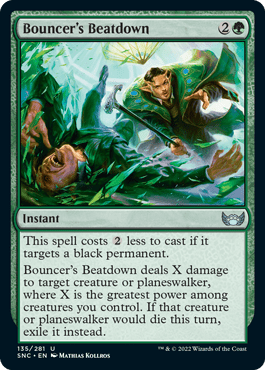
Rating: 7/10
Bouncer's Beatdown looks like a great and very versatile removal spell for green. These effects usually get blown out because they target your creature but this one just checks the biggest creature you have and checks the next one if it’s removed in response. You can’t get much better when looking for green removal spells.
Broken Wings

Rating: 2/10
We’ve seen Broken Wings a number of times now and it always ends up the same: not good enough for the main deck but excellent sideboard material. If your opponent has multiple flying creatures or broken artifacts or enchantments then you’d love a copy or two of this to sure up the post-sideboard games.
Cabaretti Initiate

Rating: 3/10
Gaining double strike isn’t a huge payoff for a card as weak as Cabaretti Initiate, but it does mean that you can get paid off rather nicely for putting +1/+1 counters or other buffs on it. I don’t think this particular sweet rabbit will be all that useful for you otherwise.
Caldaia Strongarm

Rating: 3/10
Unlike some of the other blitz cards we’ve seen so far, all of the modes on Caldaia Strongarm seem kind of mediocre.
You have a vanilla 4/5 or a 2/3 that puts some counters on something else if you hardcast it. You get two +1/+1 counters and a fresh card for four mana if you blitz it. These effects aren’t nothing, but they feel like they’ll fall on the weaker end of cards in this archetype.
Capenna Express
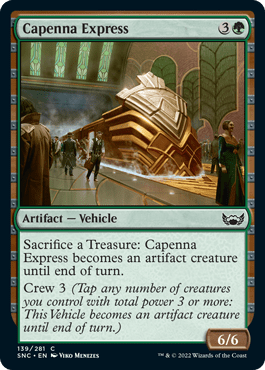
Rating: 3/10
Capenna Express is literally Futurist Sentinel, a virtually unplayable card, with one key difference: if you’re a heavy Treasure deck and can crew this using Treasures then all of a sudden I think you have a good card. You shouldn’t play this in a random green deck, but it looks pretty solid if you can do this reliably.
Civic Gardener

Rating: 4/10
A 2-drop 2/2 citizen didn’t need a good ability to already be a solid common. But having pseudo-vigilance is very nice, and you might be able to use Civic Gardener to cast two spells on turn 3 and get really far ahead depending on how your draw goes.
Cleanup Crew
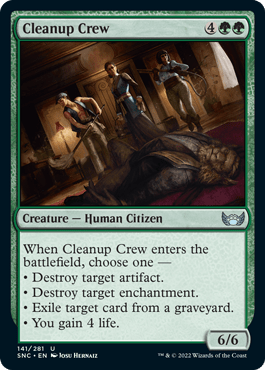
Rating: 6/10
We’ve seen how powerful cards like Ravenous Lindwurm and Hill Giant Herdgorger are in Limited since they’ve appeared in a lot of the last few sets. Cleanup Crew is just as good and even provides you with some extra options just in case there’s something else you want to do with it, but the easiest default option will be to gain four life, and that’s very much fine by me.
Courier’s Briefcase

Rating: 7/10
Courier's Briefcase is a really cool design that reminds me a lot of Prosperous Innkeeper, except it’s the other way round. Having the option to sacrifice this later on to draw three cards is a huge upgrade over normal Treasures. It also means that your simple 2-mana ramp spell doesn’t become dead in the late game, which makes me really want to prioritize this over other cheap Treasuremakers.
Elegant Entourage
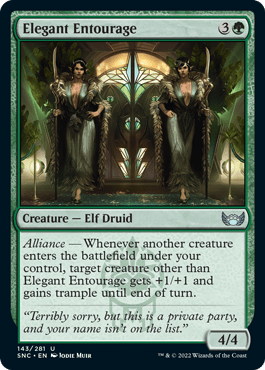
Rating: 6/10
You can’t really go wrong with a 4-mana 4/4 with upside, and it’s a pretty nice upside at that. Not only giving +1/+1 but also trample to another creature is a pretty big bonus to get off of alliance. Elegant Entourage should really help to break through a board stall while also being an efficiently-sized creature itself.
Evolving Door
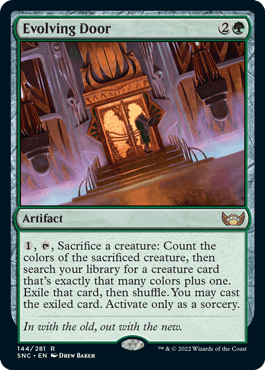
Rating: 4/10
I do love a good pun, and I definitely like a Birthing Pod card. Evolving Door looks very close to unplayable, but the more I read it the more I’m coming around on it.
We’ve seen a lot of very reasonable blitz creatures that are monocolor, so consider that you can use this to sacrifice them for just one mana and turn them into a dual-color creature. Your average deck in this format is very likely to have a few of those and that means you end up cashing in your blitz creatures for two whole cards.
I don’t think this card is exceptionally good, but that application does warrant a closer look. And if this ends up being good then I’ll be very happy to play it myself.
Fight Rigging
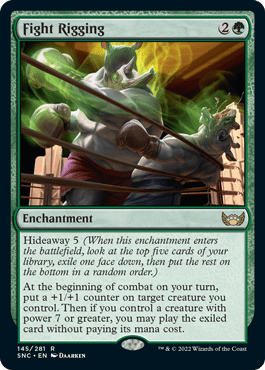
Rating: 8/10
Even if you ignore the hideaway part of Fight Rigging, this enchantment is absurd. A free +1/+1 counter every turn with no costs or restrictions is very powerful and will escalate very quickly.
This reminds me a lot of another pretty broken card, Sparring Regimen. We liked that card a lot in Strixhaven and this seems to be a very natural successor.
For the Family
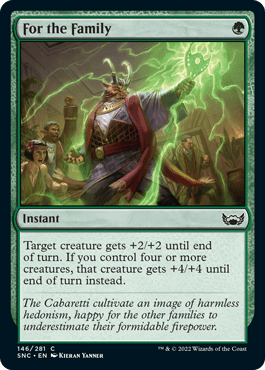
Rating: 2/10
Even if For the Family was an unconditional +4/+4 it wouldn’t be all that exciting and not that dissimilar from just Giant Growth. This is just a weak combat trick without giving any keywords, but it’s serviceable if that’s what you’re looking for.
Freelance Muscle
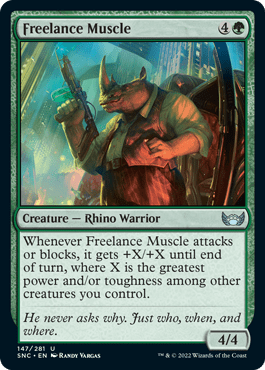
Rating: 4/10
The thing really going against Freelance Muscle is its lack of keywords or any kind of evasion. It’s very easy for this to attack as around a 7/7 or 8/8 on most boards, but that’s all it does. It can really easily be chump blocked and it’s vulnerable to removal, so it’ll rarely be anything more than just an oversized vanilla creature.
That said, you can certainly find ways to give it trample, flying, or some other abilities, at which point it becomes very powerful.
Gala Greeters

Rating: 7/10
Although you can’t give it multiple +1/+1 counters in the same turn, Gala Greeters still seems like a great 2-drop for any point on the curve. It only looks bad if you play literally no more creatures for the rest of the game, even if you draw it late, since even one or two more lets you gain some life to stabilize a bit.
If you land this on turn 2 then it quickly becomes a threat that your opponent has to deal with or they’ll likely be under too much pressure.
Glittermonger
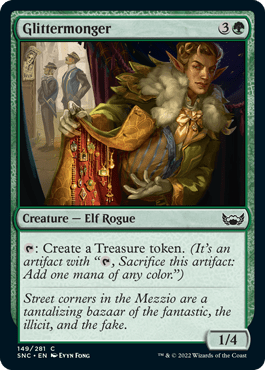
Rating: 3/10
While I like 4-drop mana dorks a decent amount, Glittermonger is significantly weaker than I’d want out of that kind of creature. It might offer you enough upside if you’re in a dedicated Treasure deck, but I don’t think it’s good enough outside of that.
High-Rise Sawjack
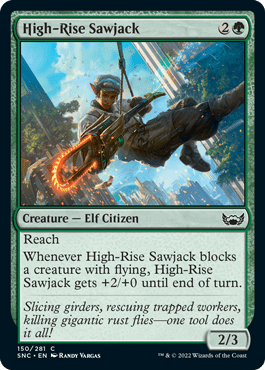
Rating: 5/10
Netcaster Spider was always a strong card and High-Rise Sawjack even has good tribal synergies going for it? I’m in.
Jewel Thief
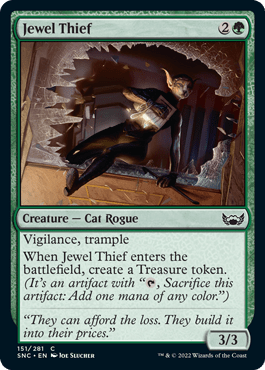
Rating: 6/10
I immediately jumped to Facebook to compare Jewel Thief to Centaur Courser when I saw it spoiled. 3-mana 3/3 creatures used to be exceptional and are slightly outside the realms of playable these days, but stick three big upsides on it and you have a very sweet deal indeed.
This is an excellent curve filler that will ramp you to five mana on turn 4 while also fixing your colors and acting as an enabler for the Treasure decks. What a card! This has got to be one of the best mono green commons in the set.
Luxurious Libation
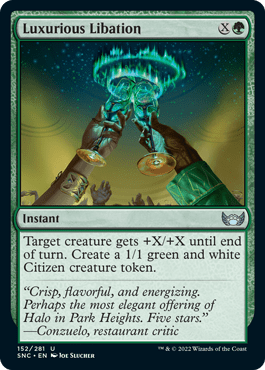
Rating: 5/10
On one hand, an X spell that gives +X/+X is really weak and is rarely as good as just a Giant Growth or Titanic Growth. But the extra Citizen token that Luxurious Libation creates really makes all the difference. That turns it from being a weak combat trick into a combat trick with a stick attached which really opens up a whole new realm of possibilities.
If +2/+2 is all you need for a creature to win a combat, then you get to do that plus create a token at the same time for three mana. You can even cast this for X=0 (assuming you have a target) and create the Citizen token for just one mana at instant speed if that’s something you really want. And having a creature enter at instant speed could allow your alliance triggers to go off as combat tricks.
This is a surprisingly flexible card that has a lot of play to it and will probably be better than its counterparts usually look.
Most Wanted
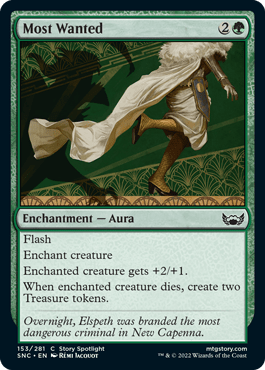
Rating: 2/10
I like flash auras since they can function as combat tricks, but giving +2/+1 just isn’t enough to help most creatures win their fights. Getting two Treasures back when the creature dies is certainly a bonus but really not worth it to play Most Wanted in the first place.
Prizefight
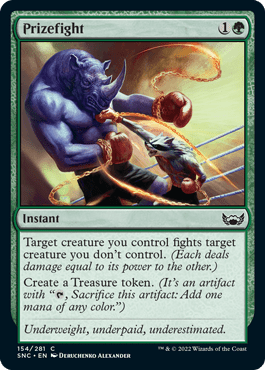
Rating: 5/10
Instant-speed fights are much better than when they’re sorcery-speed. Prizefight should be a decent removal spell and the sizes of the green creatures in this set look big enough to effectively make use of fight spells.
Rhox Pummeler

Rating: 1/10
I just don’t think a shield counter is worth it to play a bad 6-drop. Don’t get me wrong, I love big expensive dorks, but you’re just not getting much for Rhox Pummeler. The three toughness is also a huge liability since the shield counter doesn’t protect it from dying to Deal Gone Bad or Whack.
Riveteers Decoy

Rating: 4/10
A creature that has to be blocked might sound appealing, but unless you have a very specific scenario it still gives your opponent too much control over what’s blocking it for Riveteers Decoy to be that powerful.
Of course, if your opponent has just one creature up to block then this effect is very nice. You can trade off with that creature or just make it so it can’t block your better creatures.
You can find these niche scenarios every so often, but most of the time it just won’t line up favorably for you. Be prepared for a little disappointment from time to time.
Social Climber

Rating: 5/10
We’ve seen a lot of Soul Warden effects in the past, most recently with Kor Celebrant in Zendikar Rising, and they usually play out really well. A 3/2 for three is big enough to brawl with other creatures and Social Climber is likely going to gain you a substantial amount of life if it’s left in play for a few turns.
If this ends up just being Inspiring Cleric then it would be exceptional, and it’s going to end up that way without too much work a lot of the time.
Take to the Streets

Rating: 2/10
Overrun this is not. While your citizens get the full +3/+3 bonus, vigilance doesn’t do anything to help them sneak damage through. The Cabaretti decks look like they want to go a lot wider than we’re used to with a lot of 1/1 Citizen tokens, so maybe this is the perfect place for an Overrun-style card.
But without giving trample or some way to guarantee some damage I just don’t think Take to the Streets will be worth it. But I’d love to be proven wrong because I do like playing this kind of card.
Titan of Industry
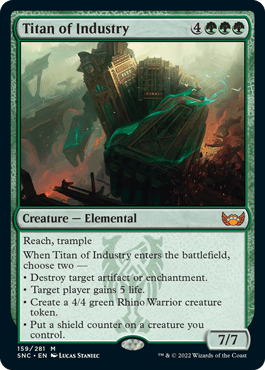
Rating: 10/10
Normally I dock 7-drop mythics a point or two since seven is really hard to get to, but Treasure tokens should make that a trivial matter here. Titan of Industry is absolutely massive and there’s not going to be much that your opponent can do to stop it most of the time if you just put a shield counter on it and make a 4/4 token.
If you’re really lagging behind you can always choose to gain life as one of the modes and since it has reach it’ll stop whatever onslaught is coming your way. There just isn’t a scenario where this card is bad, assuming you can cast it. And like I said that shouldn’t be too difficult to do thanks to Treasure tokens.
Topiary Stomper

Rating: 7/10
You might be wondering what a 3-mana Rampant Growth needs to do to be playable. Well, I see your question and I raise you this right here. The biggest problem on Topiary Stomper is double green, but I can imagine a lot of green decks in this format might lean their mana bases towards green because it has more access to color fixing, and this is a great reason to do so.
Being pacified until you hit your seventh land isn’t much of a downside since you’re likely to get there eventually. And when you do you unlock a nice medium-sized creature for your efforts. Acceleration and color fixing are key in this format and this does exactly that for you.
Venom Connoisseur

Rating: 5/10
Deathtouch works really nicely on a 2/2 creature and what I really like here is the threat of activation. If you leave mana up late in the game, can your opponent really afford to block your 3/3 with their 6/6 and risk a trade? There are a few instant-speed ways to make creatures and it’s a major loss for them if you have one.
Even just playing your creature in the main phase and attacking with Venom Connoisseur is really threatening, especially when their only option is take the two or trade with a much better creature. I like the options that this gives you and I expect it to play out really nicely.
Vivien on the Hunt
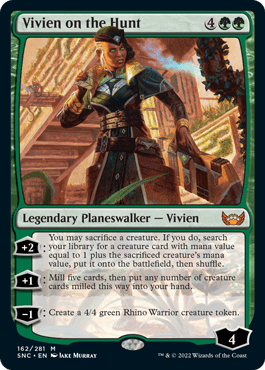
Rating: 10/10
Vivien on the Hunt is a monster this time around. Six mana is a lot, but its numbers are really absurd for that.
The key ability I’m looking at here is the -1 to make a 4/4 Rhino token. Given that Vivien starts on four loyalty you can make quite a few rhinos before losing it, and they should go a long way towards winning the game for you. While the card’s other abilities are a little less desirable they’re still very powerful and will be good for you in the right situations.
Can you imagine blitzing in one of the many 5-drops in the set, getting an attack in, and then sacrificing it to Vivien’s +2 to get your card back and turn it into a 6-drop that won’t die at the end of the turn? I can definitely imagine it and I look forward to doing it myself. I especially look forward to adding Vivien to my Birthing Pod-themed Commander deck.
Voice of the Vermin
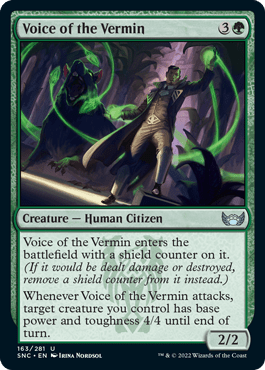
Rating: 5/10
This ability can target itself, making Voice of the Vermin effectively a 4-mana 4/4 with a shield counter, and that’s a pretty good rate. Spreading the power buff to other creatures, particularly flying or trample creatures, is also a great choice to have if you expect your opponent is likely to chump block to remove the shield. It’s also a citizen, for what it’s worth.
Warm Welcome

Rating: 5/10
Impulse-style effects like Warm Welcome are usually pretty rough. They look less than useless if you miss on finding the right card then. But one that’s tacked onto a Citizen token never truly misses. It’s also an instant, and triggering alliance at instant speed is some great functionality for the Cabaretti decks.
Workshop Warchief
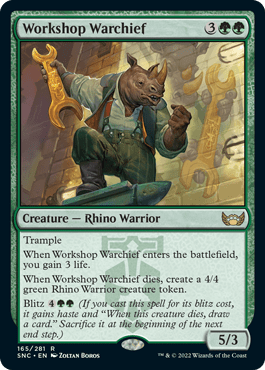
Rating: 9/10
Thragtusk? Is that you? Hey! How’ve you been?
This lovable Rhino Warrior is going to make a big impact in any game you play it in. Gaining life on a 5/3 trampler is great, and replacing itself with a 4/4 token when it dies is even better. I don’t know if you ever want to blitz Workshop Warchief but you’re getting in a hit with a 5-power haste trampler and getting nice value out of doing it if you do.
Everything about this card is just great, there’s really no downside to speak of.
Multicolored
Aven Heartstabber
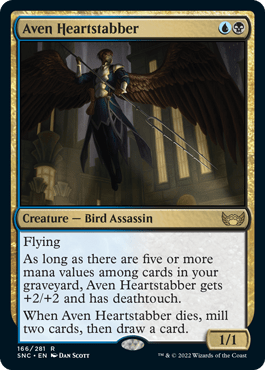
Rating: 5/10
While it’s hard to tell how easy it’ll be to get to five different mana values among the cards in your graveyard, Aven Heartstabber is perfectly serviceable as a 1/1 flier that draws a card when it dies. If it’s fairly easy to become a 3/3 deathtouch flier then its value will go up a little bit, but it’s a fine card without it as it stands.
Black Market Tycoon
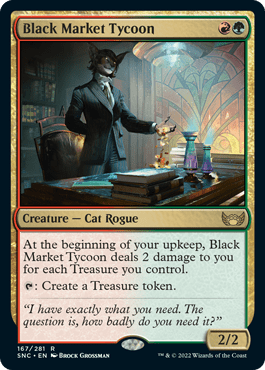
Rating: 7/10
This cat is basically just a mana dork with some extra late game functionality since you’ll be able to turn Treasures into better things. That sounds good to me.
Black Market Tycoon’s downside is going to be irrelevant most of the time if you just spend your Treasures efficiently, something that this deck is looking to do anyway.
Body Dropper
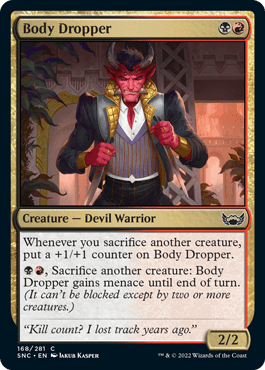
Rating: 5/10
Getting a +1/+1 counter whenever you sacrifice a creature is a great payoff, especially for a common 2-drop. You won’t be sacrificing creatures to the second ability on Body Dropper very often, but it can make for a devastating swing if you find the right moment.
Brazen Upstart

Rating: 5/10
What’s not to love about a decent-sized creature that probably draws you a real spell when it dies? Brazen Upstart is a little bit unreliable for me to give it a higher grade, but you should be very happy to grab this for your deck assuming you can cast it.
Brokers Ascendancy

Rating: 9/10
Although you run the risk of having no creatures in play, the fact that Brokers Ascendancy buffs every creature every turn with absolutely no extra costs to pay and no restrictions on it is just disgusting. Have this in play for a few turns and it’ll have contributed a ridiculous amount of raw stats to the board and will push you further and further ahead every turn.
It doesn’t do anything when you’re pretty far behind which is really the only reason I’m not giving it a perfect 10, but it’s extremely close and one of the best cards in the set for sure.
Brokers Charm
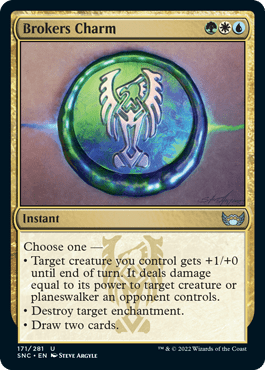
Rating: 7/10
I do love a cycle of Charms, and they should always fall right around this mark as long as they have a strong removal mode. Brokers Charm has that going for it but is also a Divination if you want it to be, or even a Demystify if you really want that.
You mostly care about the removal mode in Limited, and it’s a pretty good one. It even has the potential of being a 2-for-1 in the right circumstance if played during combat, especially if you use it on a first strike creature.
Cabaretti Ascendancy
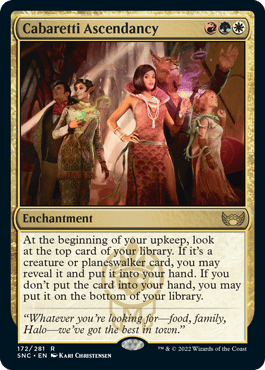
Rating: 6/10
Cabaretti Ascendancy is essentially a pseudo-Phyrexian Arena that draws you an extra card on some upkeeps while letting you scry away excess lands or situational spells that you’re going to draw. This provides you with enough of an advantage to be something you actively want, but it takes quite a while for it to pay you back for the mana you invested into it.
Cabaretti Charm

Rating: 6/10
While I’m not particularly impressed with a removal mode that deals a variable amount of damage, all of these modes are good for what the Cabaretti want to be doing in this set. Making two Citizen tokens might be the best mode on Cabaretti Charm since it lets you trigger alliance abilities and get the boosted second modes of them, and it does all of that at instant speed.
Of course, it acts as a very straightforward removal spell on most boards, but the fact that its modes all work on different board states gives this card a great amount of flexibility.
Celestial Regulator
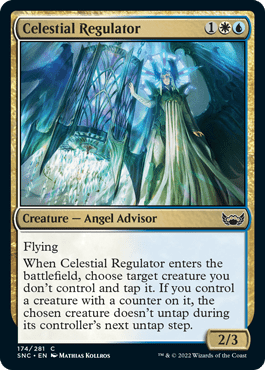
Rating: 6/10
Frost Trickster was a great card and a 2/3 flier for three that taps a creature on entering is still a good card and a really great deal for a common creature, even if you have to meet a condition to get Celestial Regulator’s full effect.
Ceremonial Groundbreaker

Rating: 5/10
If you’re equipping Ceremonial Groundbreaker for three mana it’s a little on the weak side, but equipping it for one in a Citizens deck is no joke. Most Citizens will be 1/1 tokens and being able to turn them into 3/2 tramplers for just one mana is really strong.
All-in-all this is too weak if you don’t have a lot of citizens, but this is a great payoff that makes good use of 1/1 tokens in a dedicated deck for it.
Civil Servant
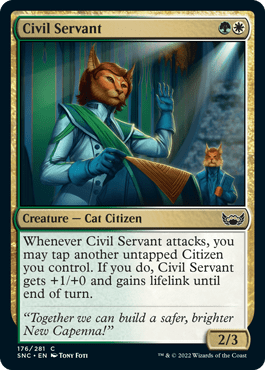
Rating: 5/10
A 2/3 is a really good rate for a common 2-drop and Civil Servant should be able to attack as a 3/3 with lifelink most of the time in a dedicated Citizens deck, and I’m definitely in for that.
Cormela, Glamour Thief
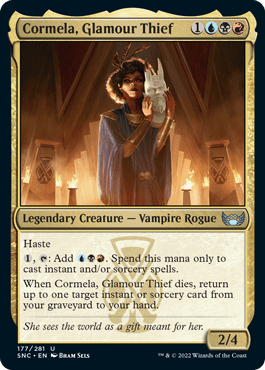
Rating: 5/10
It’s kind of weird to see a defensive card that has haste, but here we go. Cormela, Glamour Thief looks like a nice way to power out spells, but it’s not actually fixing your mana for you given that you needed all three Grixis colors to cast it.
It does at least give you enough of a jump on mana to be able to cast creatures and spells in the same turn, which is especially good if you want to blitz a creature and then sacrifice it to casualty in the same turn. The card also replace itself later which is a nice upside, but all-in-all I think it’s just average. You won’t really miss this if you don’t get it for your deck unlike other similar spell build-arounds.
Corpse Appraiser

Rating: 6/10
I always love a good solid creature that gives you value. A 3-mana 3/3 that draws you a card is right up my alley and I’ll always be happy to pick Corpse Appraiser up. It’s pretty hard to play on curve thanks to the difficult color requirement and the cost of needing a creature to exile, but that’s not a problem since this is a great play at any point on your curve and a great late game top deck.
Corpse Explosion
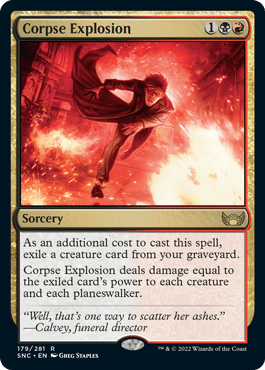
Rating: 7/10
It shouldn’t be too hard to set Corpse Explosion up and you can play around it if you know you’re going to play it by making sure you only play out creatures that won’t die to it and making sure a good-sized creature goes to the graveyard. This will probably only get to deal about three damage to each creature on average which isn’t bad, but you can of course go a bit deeper and throw an even bigger creature out to kill everything, and that flexibility adds a lot to this.
Any 3-mana spell capable of being a board wipe no matter how big the creatures on the battlefield are (I’m looking at you, Toxic Deluge) is worth a second look.
Crew Captain

Rating: 7/10
Crew Captain is a very simple card, and one that I like a lot. There are quite a lot of beefy haste creatures in this set and having one that’s pretty much guaranteed to get a free hit in is very nice.
It gets a lot worse after your one free hit and will probably end up trading down. But given that you’re a Riveteers deck you can presumably find ways to take advantage of that by either sacrificing it for extra value or some other method.
Darling of the Masses
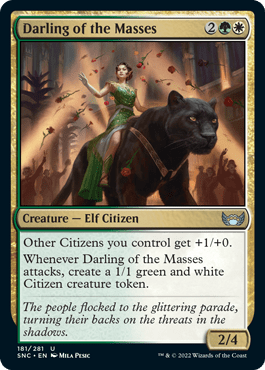
Rating: 7/10
Darling of the Masses looks like a great payoff for the Cabaretti and, most importantly, for Citizen tribal. Citizen tokens are only 1/1s so they really can’t accomplish much, but +1/+0 to all of them turns them into very real threats. And it’s not unreasonable to expect your Darling to get an attack or two in and create more as a 2/4 body.
Disciplined Duelist
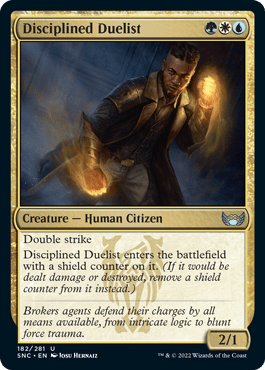
Rating: 6/10
Shield counters are likely overcosted, but it does seem very fair on a double strike creature in particular. The downside of shield counters is that any amount of damage knocks them off, but at least with double strike at work you can avoid taking damage against quite a few creatures, guaranteeing your shield only comes off when battling a big creature.
Disciplined Duelist still seems a little overcosted to me, but I think the stats are there to justify this.
Endless Detour
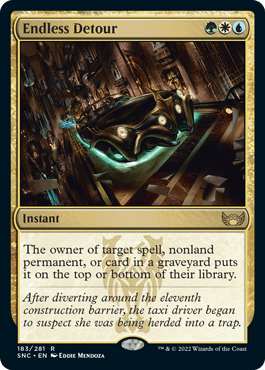
Rating: 7/10
Endless Detour is a very versatile removal spell that answers basically anything that can be thrown at you. We saw firsthand just how powerful Aether Gust can be when it saw play across a variety of Constructed decks and still sees some play in Modern.
They may get the spell back if they choose but they waste a draw step to do it, making this still a one-for-one. The flexible nature of this card opens you up to getting even more value from it, and that gives it a lot of potential.
Evelyn, the Covetous
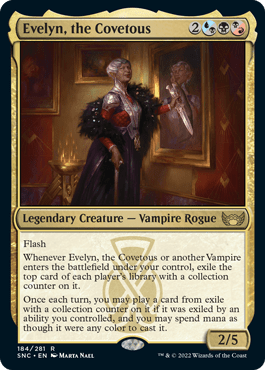
Rating: 8/10
Evelyn, the Covetous will effectively draw you two cards when it enters, but you can only play one of them per turn. That’s still a great deal even with all of the restrictions on it. There are quite a few Vampires in the Maestros too, so getting more triggers on later turns isn’t that unlikely and drawing two cards whenever you play a vampire is a huge payoff.
Evelyn gives you a lot to like in a very neat little package, and you can even play it for mono-black or in a 2-color deck, so you should probably take this and be happy.
Exotic Pets
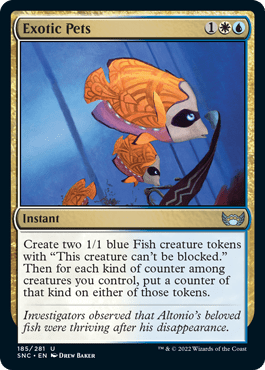
Rating: 7/10
I’ve already mentioned that these unblockable Fish tokens seem extremely powerful, so I’m all in for a spell that makes two of them for three mana. But you also get to grab a +1/+1 counter or a shield counter depending on the rest of your board? I have a feeling Exotic Pets is just incredible and probably even worth splashing in the Cabaretti tokens decks.
Falco Spara, Pactweaver
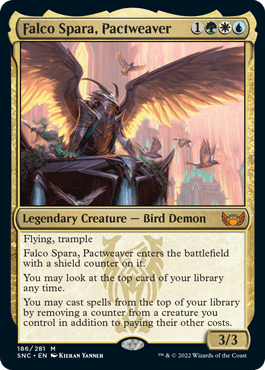
Rating: 8/10
You’re already getting a good raw deal from Falco Spara, Pactweaver’s stats, let alone factoring in the ability to cast spells from the top of your library. While I don’t especially want to trade in shield counters for more cards, the option is still there. And no matter what you’re paying you’re getting to cast a spell that wasn’t in your hand, and that’s huge.
Fatal Grudge
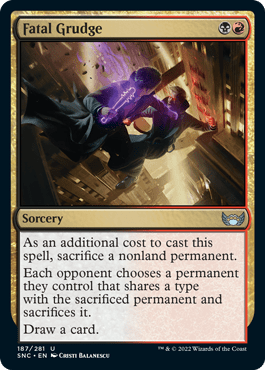
Rating: 3/10
Most of the time Fatal Grudge is just going to be a fancy Cruel Edict. You sacrifice a weak creature, your opponent sacrifices one, and you draw a card. There are enough throwaway creatures and 1/1 tokens lying around this set that this is just not an effective removal spell.
If you play it you’ll find a few scenarios where it feels like you got a good deal, but even with the card draw you’re only trading 2-for-2 and it probably won’t end up being worth it.
Fleetfoot Dancer
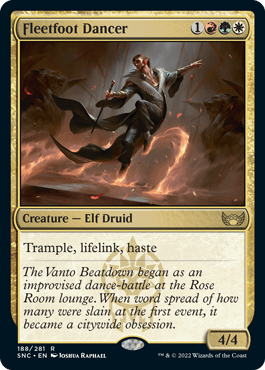
Rating: 8/10
Like Mantis Rider and Lightning Angel before it, this keyword-soup creature is going to be pretty powerful. Haste, trample, and lifelink are a nasty combination that make it almost impossible for your opponent to win any races. Fleetfoot Dancer has to be killed and any efficient creature that draws that kind of attention is bound to be one of the best cards you can get.
Forge Boss
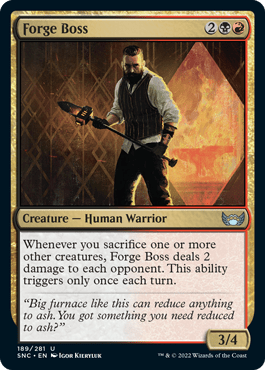
Rating: 6/10
A 3/4 for four mana is a nice size and hitting your opponent for two damage is quite a big chunk, even if Forge Boss can’t trigger multiple times each turn. This ought to be a really nice payoff for your blitz and sacrifice decks.
You can kind of get around the restriction by sacrificing something on your turn and then something else on your opponent’s turn for a bit of extra damage.
Glamorous Outlaw
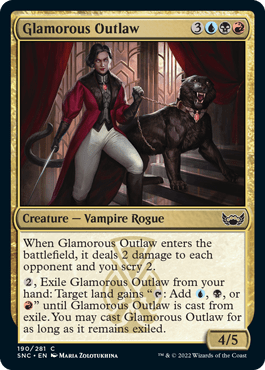
Rating: 5/10
Glamorous Outlaw is the first in a cycle of 3-color mana fixers that’s likely going to be very important for the set. Spending a whole card to turn one of your lands into a tri-land would normally be a terrible deal, but you never actually lose the card thanks to the way these are structured.
The creatures are a bit weak but also not embarrassing given that you get early fixing and then a perfectly reasonable spell later. Fixing is very important in a set like this and these would end up very high pick commons if they were basic landcycling cards or something similar.
Hostile Takeover
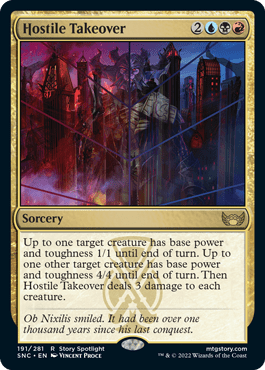
Rating: 8/10
Most “three damage to everything” spells tend to scale poorly into the late game, but Hostile Takeover is a whole other story. This spell is always guaranteed to kill at least one creature and save at least one of yours at the same time. Depending on the situation you can set this up as a Plague Wind sort of effect, and it’ll likely be the best card in your deck if you can get that to work.
Incandescent Aria

Rating: 6/10
Cabaretti decks are naturally going to have a lot of tokens which will make Incandescent Aria a card with the potential to become a Plague Wind, not unlike Hostile Takeover. While having that potential is great you should also be very aware of the fact that it might just be bad in certain matchups, like against other tokens decks or decks with mostly large creatures. I’d definitely start it in the main but be very aware of boarding it out when the matchups aren’t aligned.
Jetmir, Nexus of Revels
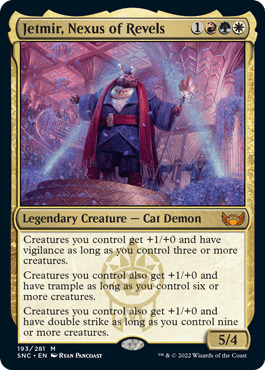
Rating: 8/10
These token decks are really going to want ways to pay you off for having so many creatures, and I can’t think of a better pay off than Jetmir, Nexus of Revels. Having three creatures out, including itself, isn’t that hard to do. The sweet spot is going to be getting to six creatures which will turn all of your 1/1 tokens into 3/1s with trample, and that’s a great spot to be in.
Jetmir does come at a cost since this ability is very easy to interact with. Your opponent could remove creatures at instant speed to reduce the number of creatures in play and remove one of its buffs, but this should just be a huge bomb for aggressive token decks assuming you’re prepared for that.
Jetmir’s Fixer
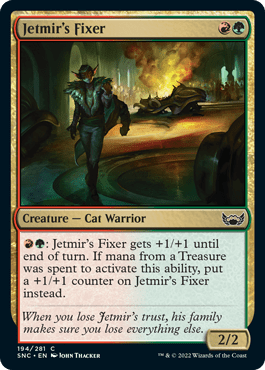
Rating: 5/10
Jetmir's Fixer is a super solid common where you not only get to attack often thanks to the threat of activation implied by this ability, but you get to start growing it permanently and turning it into a really potent threat later in the game. 2-drops that have uses when you draw them later are extremely high value and this is one of the better ones I’ve seen in this set.
Jinnie Fay, Jetmir’s Second
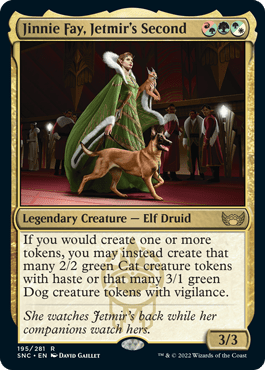
Rating: 9/10
While these effects are usually clunky because they appear on enchantments or other spells, having this on a creature is huge. Jinnie Fay, Jetmir's Second functions fine as a 3/3 for three and it pays you off big time when you finally make some tokens.
While “evolving” your 1/1 Citizen tokens into these cats or dogs isn’t that big of an upgrade, what’s most interesting about this ability is that it also works on Treasure tokens. All of a sudden cards that make multiple Treasures start to make a pair of token creatures and even Bootlegger's Stash looks like a viable card.
This has a lot of potential to overwhelm opponents with a ton of creatures out of nowhere, and that sounds like exactly the kind of card that decks in this color combination need.
Lagrella, the Magpie
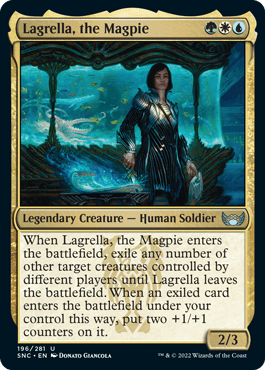
Rating: 8/10
While probably one of the most confusing abilities in the set, Lagrella, the Magpie is still just a Banisher Priest with some upside. You get to exile one of your opponent’s creatures when this enters the battlefield, but also have the option of exiling one of yours so that it can come back later with two +1/+1 counters.
Given that the Brokers have a lot of creatures that enter with shield counters, this could be a great way to effectively regenerate those shield counters and retrigger ETB effects or remove negative auras. Being a better Banisher Priest was already good enough for this grade, and the extra functionality is a really nice touch.
Lord Xander, the Collector
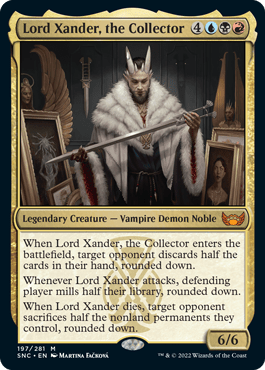
Rating: 6/10
From the minute Lord Xander, the Collector was spoiled, Commander players the world over started concocting brews with it and I’m not surprised. This isn’t quite as exciting in Limited.
Discarding half your opponent’s hand isn’t going to do much since they probably have a very small hand by the time you get to seven mana anyway. Milling half of their library isn’t going to be effective unless you combine it with other mill effects or get multiple attacks in. And sacrificing half of their nonland permanents isn’t even that great since they have full control over what they lose and thanks to “rounded down” there will never be a situation where your opponent is forced to sacrifice their best card.
While each of these effects is definitely not nothing and they’re good enough to give this card a half decent grade, they’re not quite as devastating as you might think and that’s worth remembering.
Maestros Ascendancy
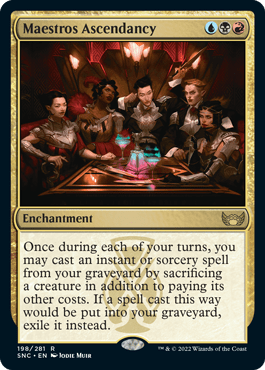
Rating: 6/10
If your Maestros deck ends up heavy on spells then Maestros Ascendancy can become a really nice value engine. But this doesn’t do a whole lot and is probably best left in your sideboard if you don’t have enough spells to make it useful, or even enough sacrificial lambs to pay for the costs.
Maestros Charm

Rating: 7/10
Maestros Charm is easily one of the better Charms in this cycle and has a very simple design to it. You can either kill a creature, swap it for another card, or just send some damage to the face, which you’re only going to do if it wins you the game. This is just a great removal spell with extra options available and that’s enough to make it incredible.
Maestros Diabolist
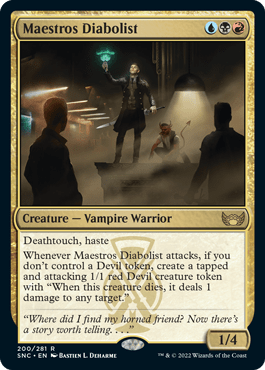
Rating: 7/10
Maestros Diabolist is a really nice engine to spew out fodder for your casualty spells. These 1/1 Devil tokens have proven themselves to be very powerful in previous sets and nothing has changed now. A 1/4 deathtouch creature is able to attack into most boards since your opponent isn’t going to want to trade it off for anything particularly big, so it’ll be relatively easy to make a token each turn.
While casualty is the main focus for the Devil tokens since you want to sacrifice them to keep creating more, this is very splashable in a Riveteers deck to give you extra fodder there. I think this is a great card with a lot of applications across this set.
Masked Bandits
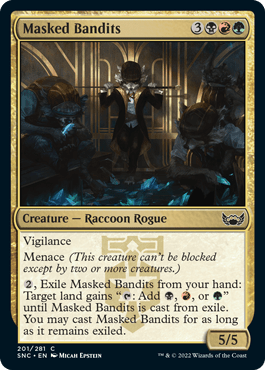
Rating: 5/10
Like the other members of this cycle, Masked Bandits should be great mana fixing and gets the same grade as the others. But this is one of my favorite ones based on the raw stats you get.
Meeting of the Five

Rating: 0/10
While a 5-color deck is most certainly not out of the question in this set and something I’ll likely attempt to do every time I draft it, Meeting of the Five is just not going to work.
First of all, getting to eight mana is pretty difficult, though Treasures can help you get there. But the restrictions on this thing are far too constricting. Casting only 3-color spells that you find means that sometimes you’ll exile 10 cards and only find one or two to cast, which is a terrible deal given that you spent eight mana up front to go and find them.
This looks like a really fun build-around for Constructed but should be completely unplayable in Limited.
Metropolis Angel
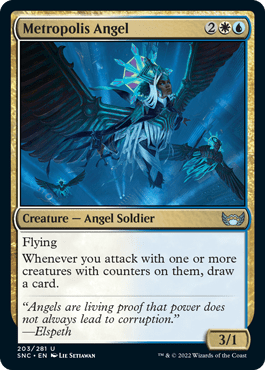
Rating: 6/10
What I really like about Metropolis Angel is that it doesn’t have to attack to trigger. If you have a creature with a counter on it, which isn’t that hard to get, you can cast this, attack, and immediately draw a card. You’ll already have gotten value if you set that up, even if your opponent untaps and kills it, and that makes it good enough already.
A 3/1 flier can be a little fragile, but not needing to attack to get good value means you often won’t even care.
Mr. Orfeo, the Boulder
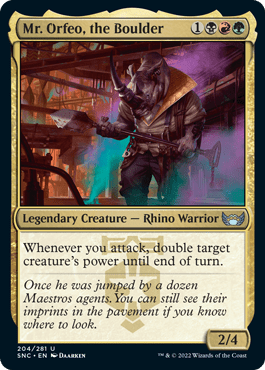
Rating: 5/10
Love the name, but the card a little less so. Mr. Orfeo, the Boulder doesn’t seem to be doing a whole lot. There are going to be some huge blowouts, like if you attack with a 6-power trample creature and get a hit in for 12, or if you have a nice big flier and get to hit for double damage. But I don’t see this doing much and it’ll often just be fine as a 2/4, but not exciting.
Nimble Larcenist
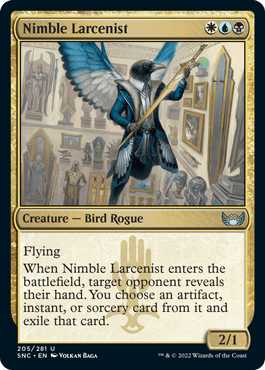
Rating: 6/10
I’ve often mentioned in these set reviews that Coercion effects are bad and you should generally stay away from them. That’s still true, but when they come attached to a decently sized creature then it’s a whole new ball game.
All Limited decks are likely to have instants and sorceries in them, so playing Nimble Larcenist early is fairly likely to hit a card for you. And you’re not unhappy having spent three mana to get a 2/1 flier and a Peek at your opponent’s hand even if it doesn’t.
Ob Nixilis, the Adversary
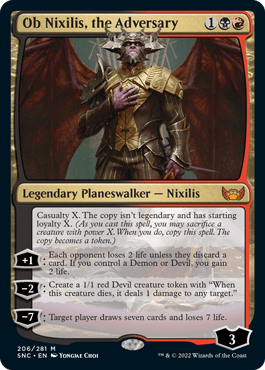
Rating: 9/10
Like most 3-mana planeswalkers, Ob Nixilis, the Adversary doesn’t do a great deal but still does just enough to pay attention to.
The casualty cost is very real and I expect you’ll want to do it most of the time you cast it. Even just sacrificing a 1/1 token gives you two Ob Nixilis’ at 3 and 1 loyalty respectively, letting you make a Devil token with one and hitting for two with the other. Having two planeswalkers in play is no joke and will start to clock the opponent quicker than they realize if left unchecked.
You don’t even need to go too far to protect them in the early turns since your opponent will find it particularly difficult to dedicate their resources to attacking both of them. Ob Nixilis doesn’t look like much, but having two of them in play is going to be massive and really hard for your opponent to deal with, and I really like that in a planeswalker card for Limited.
Obscura Ascendancy

Rating: 1/10
I initially read Obscura Ascendancy as “equal to or less than” and thought the card was absolutely ridiculous. Making a 2/2 basically whenever you cast any spell is just absurd.
Sadly I was wrong, and it only creates tokens when you very specifically cast the right mana values of cards. You even need to have a 1-drop to get the first trigger going, which isn’t the easiest thing to do. There are naturally fewer 1-drops in this set thanks to the 3-color setup it has, so there’s a good chance this card won’t even do anything for you.
And even if you do have those 1-drops, needing to cast each mana value in the right order to get max value out of this is going to be pretty hard to accomplish. If you have a good number of cards at each mana value in your deck then it’s probably worth it to try and make this work, but it won’t be worth bothering with the overwhelming majority of the time.
Obscura Charm
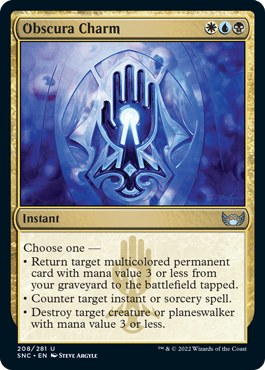
Rating: 6/10
While quite a bit more restrictive than the other Charms, Obscura Charm still offers a good amount of flexibility with a good removal mode, so I’m definitely in for it. I don’t know if you’re likely to be returning a multicolored permanent to the battlefield, but it’s definitely a good option to have and there are some very nice targets for it in the set.
Obscura Interceptor

Rating: 7/10
Remand-style effects are often better than they look, and having one attached to a very reasonable creature is something I’m very interested in.
You really want to try to make the most of Obscura Interceptor by getting the timing right since your opponent gets their card back to hand. Bouncing something that influences combat when they don’t have enough mana to try it again is a great option, but even just leaving four mana open and bouncing their turn 4 play is a great play for you.
Ognis, the Dragon’s Lash
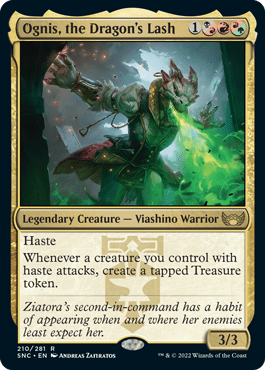
Rating: 6/10
I commented earlier that there are quite a few beefy haste creatures in this set. Ognis, the Dragon's Lash also works nicely with blitz creatures, so you should have no shortage of ways to trigger this. But it is a little small for a 4-drop, so getting back a Treasure when it attacks sort of makes up for that.
Park Heights Pegasus
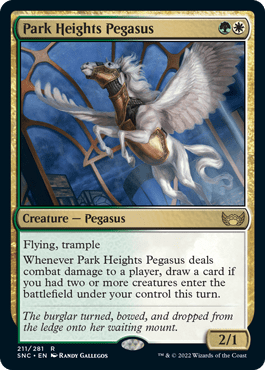
Rating: 7/10
How many abilities can they fit on a single small flying creature? I was already going to play Park Heights Pegasus if it was just a Stormfront Pegasus, but there are a lot of ways to make two creatures in a turn thanks to alliance, and this is a great way to pay you off for doing so. This on turn 2 followed by a pair of creatures on turn 3 starts putting you really far ahead before your opponent can find any kind of answers.
Queza, Augur of Agonies
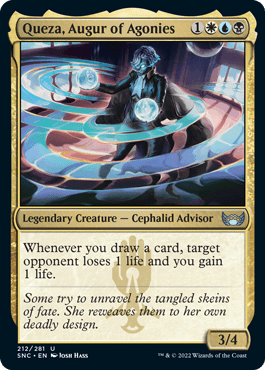
Rating: 6/10
Draining for one life isn’t much of an effect, but considering it’ll be happening every turn and often triggers multiple times in the same turn really starts to add up. Queza, Augur of Agonies is a really good size for its mana cost despite never needing to attack, so it can speed up the clock even more.
You won’t value this highly when your opponent plays it but suddenly you’ll be on six life with a draw spell on the stack wondering why you didn’t deal with it sooner.
Raffine, Scheming Seer

Rating: 8/10
Raffine, Scheming Seer is a card that looks like it can get out of hand really quickly. You can trigger it immediately just by attacking with your 2-drop if you have the right curve to be able to play it on turn 3. From there ward 1 is probably enough to keep it around for a couple turns while each attack gives you a huge amount of card selection and the ability to grow your creatures much faster than the early turns of the game allow.
Drawing it late is also great since playing it often enables a big connive on the same turn, drawing you into something you need to close out the game.
Rakish Revelers

Rating: 5/10
Rakish Revelers is probably the best card in this cycle. You’d like it regardless of the effect, but the effect also happens to be exactly what the Cabaretti decks are after: two creatures from one card.
Rigo, Streetwise Mentor
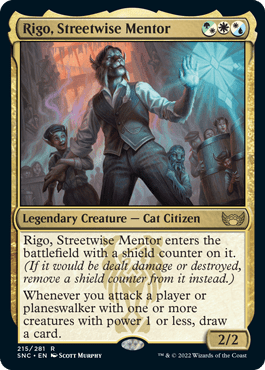
Rating: 7/10
Rigo, Streetwise Mentor is a great payoff for specifically the Citizens decks. A Gray Ogre with a shield counter just isn’t good enough, but drawing you a card every time you enter combat with a Citizen token seems great. The hybrid mana cost lets you cast this for in those decks and your Brokers decks will probably have some Citizentokens in them anyway.
Riveteers Ascendancy
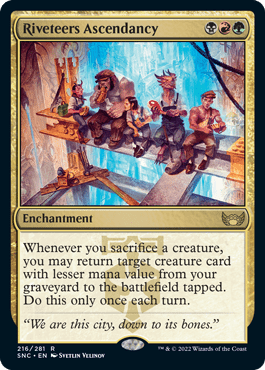
Rating: 8/10
If the bar you have to clear to make Riveteers Ascendancy work is “you need to be able to sacrifice creatures a lot,” then that seems really easy for the Riveteers to do. With this card in play suddenly every blitz creature skyrockets in value.
Take Girder Goons for example. It’s a weak creature, but if you blitz it for four mana then you can attack with it (or leave it back if the attack isn’t favorable) and sacrifice it to another effect to get the effect from the sacrifice, a 2/2 token, an extra card, and a 4-drop from your graveyard straight to the battlefield. And all of that for four mana.
This Ascendancy enables some really dirty plays and looks to be an exceptional build-around for this deck.
Riveteers Charm

Rating: 7/10
I think players have Riveteers Charm down as likely the best Charm in this cycle. The removal mode is an edict but still one that’s guaranteed to kill your opponent’s biggest creature, and the second mode lets you play probably two cards out of your top three, which is an incredible rate on a 3-mana draw spell.
Even exiling the graveyard might be relevant to disrupt plays out of certain Dimir decks in this format. You won’t be unhappy with any mode you cast this for.
Rocco, Cabaretti Caterer
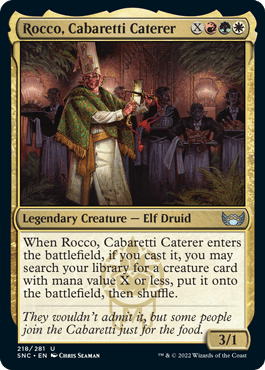
Rating: 7/10
Green Sun's Zenith is one of my all-time favorite cards and I still own the playset I used at the UK Nationals in 2011 (to a top 32 finish I might add), the first premier event I ever played in. Rocco, Cabaretti Caterer looks eerily similar and I really like that.
Three mana plus X is a lot to be paying to grab something from your deck, but it should be worth it given that you also get a 3/1 out of the deal. Six mana total gets you basically a pair of 3-drops while seven mana nets you a 4-drop and this. Any creature you grab should make this worth it as long as you cast it for at least X=2, but this card’s stock starts to rise if you have a powerful rare that costs around three mana.
Scheming Fence
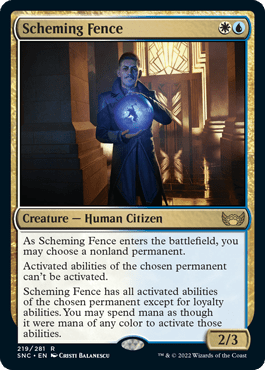
Rating: 4/10
I really like the look of Scheming Fence for Constructed, but it’ll likely do little more than be a half-decent vanilla creature in Limited. Being able to shut down a planeswalker or some other annoying permanent every now and again is an upside, but not one that upgrades it beyond the power level of an average common.
Security Rhox
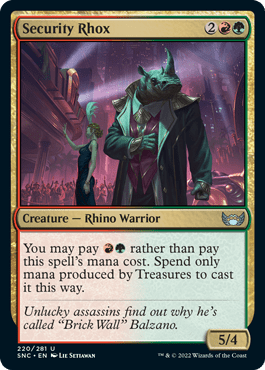
Rating: 5/10
If it was reasonable to cast Security Rhox on turn 2 like it could be in Constructed, then this would have a lot of potential. But this is probably just a good 4-drop that sometimes lets you double spell in a turn thanks to the cost reduction, and I’m very fine with that.
Shattered Seraph
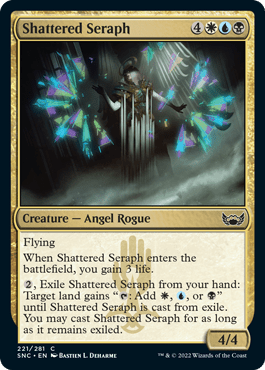
Rating: 5/10
Shattered Seraph is probably the weakest of this cycle simply thanks to how expensive it is. But that doesn’t change the fact that it’s still a great card and one you’ll be happy to run in most Obscura decks.
Snooping Newsie
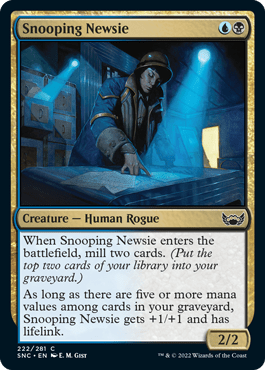
Rating: 4/10
You could do a lot worse for a common enabler for these Dimir graveyard decks, and being a 3/3 lifelinker in the late game makes Snooping Newsie a great draw later on.
Soul of Emancipation

Rating: 9/10
It’s been a while since we saw Terastodon, but it’s remained a staple for Constructed decks that cheat out big threats for well over a decade. Soul of Emancipation isn’t on the same level but lucky for us it’s actually absurd in Limited.
The main reason for that is Treasure tokens. Not only do Treasure tokens make seven mana a lot more palatable, but they’re also the perfect permanents to blow up with this card’s ability. You can also use this to pop your own shield counters and guarantee you get all three angels without losing anything you cared about.
If all of that goes right and you end up with a 5/7 and three 3/3 flying angels for just seven mana then I’m not sure how you lose from that point.
Spara’s Adjudicators
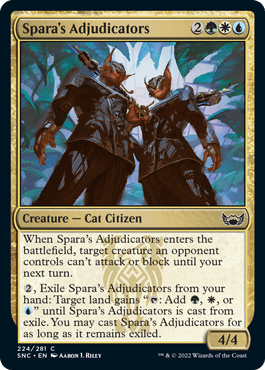
Rating: 5/10
The final entry in the mana fixing cycle is a pretty good one that might even win you a game out of nowhere. If you exiled Spara's Adjudicators early on then your opponent has to be scared of it. If they play in a particular way it may leave them open to an alpha strike they can see coming and that’s always funny when it happens.
Stimulus Package
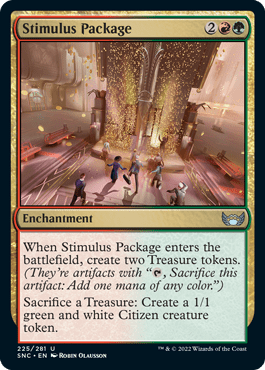
Rating: 7/10
There are quite a lot of cool payoffs for Treasure tokens, and Stimulus Package is one I particularly like. Anything that can turn Treasures into something that actually affects the board is definitely worth looking at.
If your deck is capable of making a ton of them then this is a very noteworthy consideration to turn them into real cards. This is also the other reason you might have to try running Bootlegger's Stash.
Syndicate Infiltrator

Rating: 5/10
I’m still not convinced that this plan of getting to five different mana values among the cards in your graveyard is going to work. But you won’t be unhappy with Syndicate Infiltrator as just a 3/3 flier for four mana, so you’re really not losing out even if you fall short of enabling the ability.
Tainted Indulgence
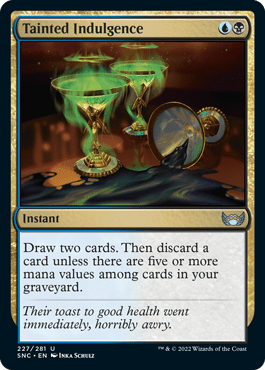
Rating: 5/10
Draw two and discard one for two mana is a pretty decent card already. Not needing to discard one when you draw Tainted Indulgence later and the game has been going on for a while definitely pushes up its value and makes it a solid card all round.
Toluz, Clever Conductor

Rating: 7/10
Toluz, Clever Conductor looks like a perfect build-around for these conniving decks. Getting every card you discarded back while they’re on the battlefield is a huge upside and this will just end up drawing you three or four cards when it dies if left in play for long enough, which makes you heavily incentivized to discard nonlands to get those +1/+1 counters and trade Toluz in combat at some point. This is pure value and I love it.
Unleash the Inferno

Rating: 7/10
While Unleash the Inferno has some nice Constructed applications to kill a creature and another permanent, that’s not likely to be the case in Limited. But seven damage to a creature for just four mana is a great rate for a removal spell and sometimes you’ll be able to pick off an annoying artifact or enchantment. So this is still great and I’d never cut it from a Riveteers deck.
Void Rend
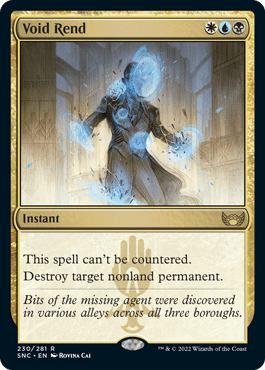
Rating: 7/10
Instant-speed Vindicate (yes, I know Void Rend only targets nonlands, but still) is an excellent card and one you’d play in every Obscura deck and honestly look to splash in any deck that overlapped two colors with it. It’s as simple as that.
Ziatora, the Incinerator

Rating: 9/10
Now Ziatora, the Incinerator is a huge pay off for blitz. We’ve already seen a lot of good blitz cards and the Riveteers mob boss legend really loves seeing you blitz them. If you blitz out any given creature then you get to Fling it at another creature on your end step as well as drawing a card (from the blitz ability), and make three Treasures to do it all again later.
Even without much blitz Ziatora is still a 6/6 flying dragon and it can Fling any creature to deal damage and kill opposing threats. This is a bomb rare no matter what.
Ziatora’s Envoy
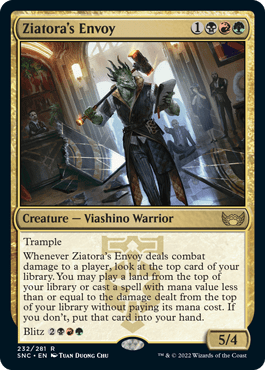
Rating: 9/10
Four mana 5/4 trample creatures don’t need to do much else to be good Limited cards, but Ziatora's Envoy goes above and beyond. Not only does hitting your opponent draw you a card, it also gives you a very good chance of getting to cast it for free.
Hit once and cast a 4- or 5-drop with this ability and you’ve already gotten back all the mana you spent on this. If you get that hit in and then cast another 4- or 5-drop with your mana then you’re so far ahead of your opponent that it’ll be difficult for them to claw back in.
Colorless
Arc Spitter

Rating: 1/10
I’m not really a fan of Arc Spitter. Your opponent has to block the equipped creature before this does anything. This does threaten to mow down whatever creatures block it, but that can just be avoided by not blocking.
Unless you put this on something good enough to warrant the block then it doesn’t do anything. Even then your creature can still be chump blocked as normal and you need a lot of mana up to threaten other blockers. It’s a cool design but I really don’t think it’s going to get there.
Brass Knuckles
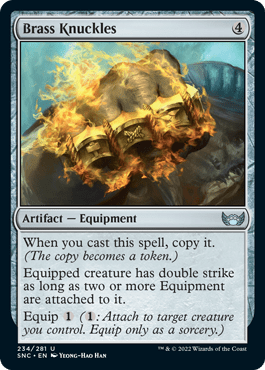
Rating: 1/10
While I love Brass Knuckles’ flavor, I don’t think it’s playable. If there was more of an equipment theme in the set then I could definitely see this being good, but you just need to keep moving both copies to each creature to give it double strike in the vast majority of situations. At that rate it’s basically a 4-mana equipment that equips for two and only grants double strike, which isn’t a card I’m interested in.
Cement Shoes

Rating: 3/10
Does WotC still think they’re releasing Kamigawa and that’s why they’re making a Naruto reference? Cement Shoes doesn’t seem awful but it locks you into a play pattern of equipping a creature, attacking with it, then moving it to another creature and attacking again next turn.
Unlike other similar equipment from the past, like Heavy Arbalest, there’s no way to get around your creature not untapping. I can definitely envision decks that want to do this, but you’re probably best off ditching the shoes just like Rock Lee.
Chrome Cat
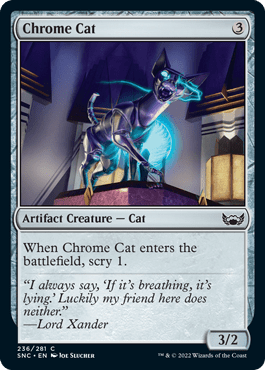
Rating: 3/10
Chrome Cat is little more than a vanilla 3/2, which you’re generally not interested in. But it can be a nice curve-filler that every deck has access to so I’d imagine you’ll see it from time to time and even have decks that want it.
Getaway Car
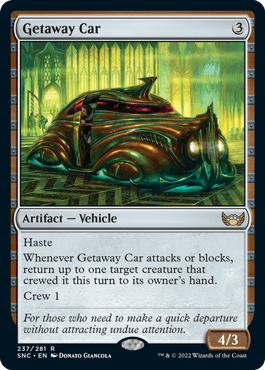
Rating: 6/10
A 4/3 haste Vehicle for three mana is pretty beefy. And with a crew cost of just 1 Getaway Car can really get in there. Being able to play it on turn 3 and crew it with nearly anything you played the turn before is a play that should put you in good stead for future turns. It’s great that you don’t have to return anything with its ability, so having the option to reuse your triggered abilities or regenerate shield tokens is a great bonus on an otherwise decent card.
Gilded Pinions
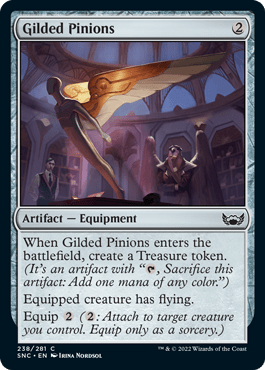
Rating: 3/10
I’ve never been a fan of cards like Gilded Pinions, but every now and again they really perform. Giving flying to any creature is a huge upside, even if you have to keep paying mana for the privilege.
Halo Scarab
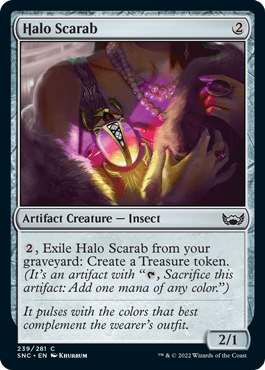
Rating: 3/10
Every deck needs color fixing and Halo Scarab might not be a bad way to go about it. I’d rather not have to cast it up front, but you can discard it to connive or cast and sacrifice it to a casualty spell, at which point it provides a nice bit of value.
Luxior, Giada’s Gift
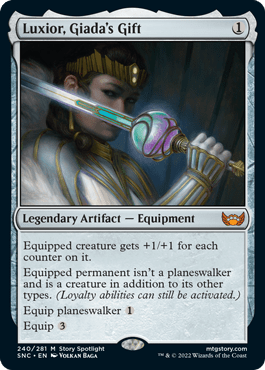
Rating: 0/10
While Luxior, Giada's Gift has some exciting Constructed applications between going infinite with Devoted Druid or turning Kiora, Behemoth Beckoner into a 7/7, it’s just not going to happen in Limited. For an equipment to be worth equipping for three mana I want to be granting at least +3/+3 and this sometimes won’t even give +1/+1. I can’t take that liability.
Ominous Parcel
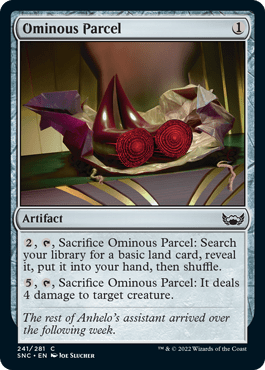
Rating: 4/10
I’ve cast a lot of Traveler's Amulets in my time, and while I’m not enamored with having to pay a little more for it, this is a set where you really want the mana fixing. Becoming a bad removal spell when you draw Ominous Parcel late is really nice though and it does at least partly make up for needing to pay more mana for it earlier.
Paragon of Modernity
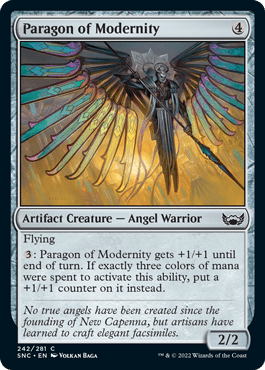
Rating: 3/10
Paragon of Modernity is a tricky one. I don’t think any deck will be that happy with the upfront cost of this, but this does become a very solid beater in the late game in a deck that has good fixing. And it’ll be enough to make an impact if it starts growing to a 5/5 or a 6/6, even when you’ve spent a lot of mana to get there.
Quick-Draw Dagger
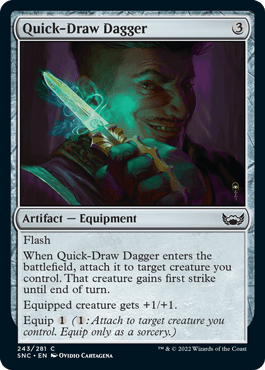
Rating: 4/10
While I don’t like combat tricks much, I do like ones that stick around and provide extra value once they’ve been used. Three mana for +1/+1 and first strike is far too much, but leaving behind a Short Sword is enough of an upside for me to be interested in Quick-Draw Dagger.
Scuttling Butler
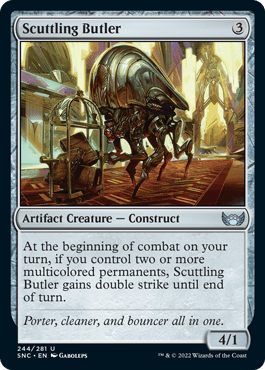
Rating: 1/10
Without the two multicolored permanents Scuttling Butler is just a vulnerable creature that dies to everything in combat and just isn’t good enough to make most decks. Even if you can reliably get two multicolored permanents out, your reward is still a 4/1 that attacks with double strike, which still isn’t enough to bother with.
Suspicious Bookcase
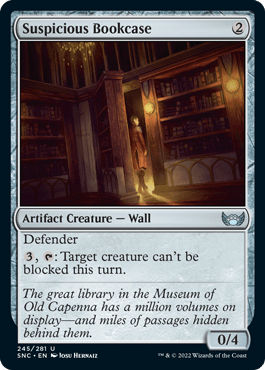
Rating: 1/10
Fortunately we’ve played with Suspicious Bookcase before and it was pretty terrible then. You might be able to find some good scenarios for this but you’ve still spent a whole card to get there, which is just not a good plan.
Unlicensed Hearse
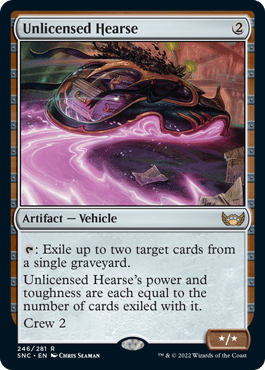
Rating: 7/10
All you need to get Unlicensed Hearse to a good size is about four cards, and that shouldn’t be too difficult to get to. Then you can grow it even more and that’s a great card that also doubles up as graveyard hate against decks where that might be relevant when the casting and crew cost are both very manageable.
Lands
The Common Dual Lands
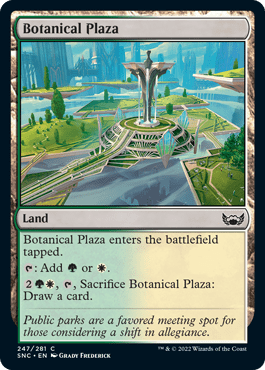
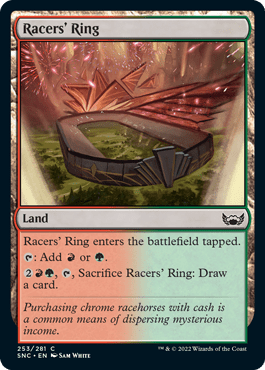


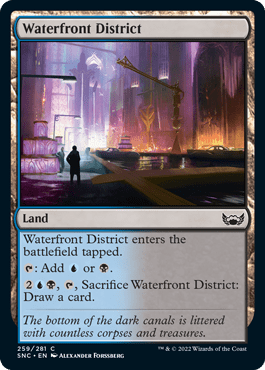
Rating: 5/10
Like I keep saying, fixing is important for this set. Here you have a great cycle of common dual lands with Botanical Plaza, Racers' Ring, Skybridge Towers, Tramway Station, and Waterfront District which will be very important to take early. These are the kinds of cards that you want to take but can’t take over good playables. Instead you’ll often find yourself needing to take them over good playables to make your deck’s mana work.
The Fetch Lands
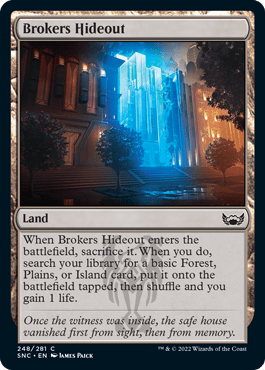
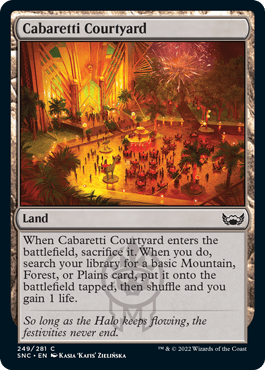


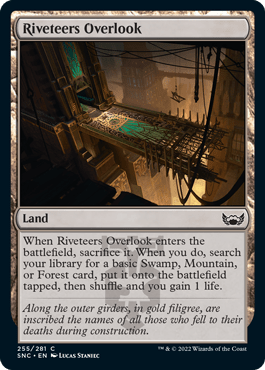
Rating: 6/10
These new fetch lands are massive upgrades over the terrible panoramas from Shards of Alara. They’re also quite a bit better than the allied duals in the set since each 3-color combination has three of them to look out for: the one in their color combination and the two that overlap with it. Brokers Hideout, Cabaretti Courtyard, Maestros Theater, Obscura Stormfront, and Riveteers' Outlook will probably be high picks and are perfect for enabling splashes.
The “Triomes”
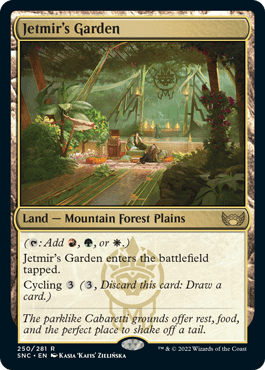
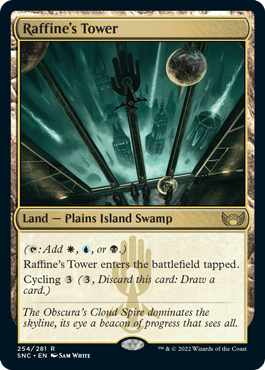
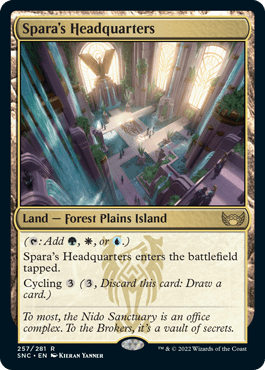
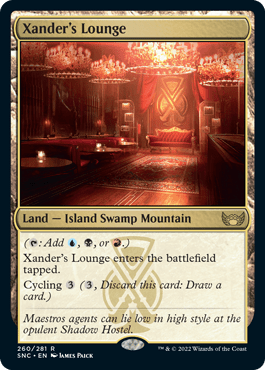

Rating: 7/10
Finally we have the other five “Triomes,” completing the cycle that was started back in Ikoria. Triomes are very powerful lands and I expect Jetmir's Garden, Raffine's Tower, Spara's Headquarters, Xander's Lounge, and Ziatora's Proving Ground to actually be good first picks similar to the tri-lands of Shards of Alara and Khans of Tarkir since fixing your mana is so important.
Making sure you can cast any spell is often actually more valuable than picking what the spells actually are. You’ll be happy casting any big gold spells, so making sure you have all of your colors is the most important thing to prioritize in a Draft.
Wrap Up
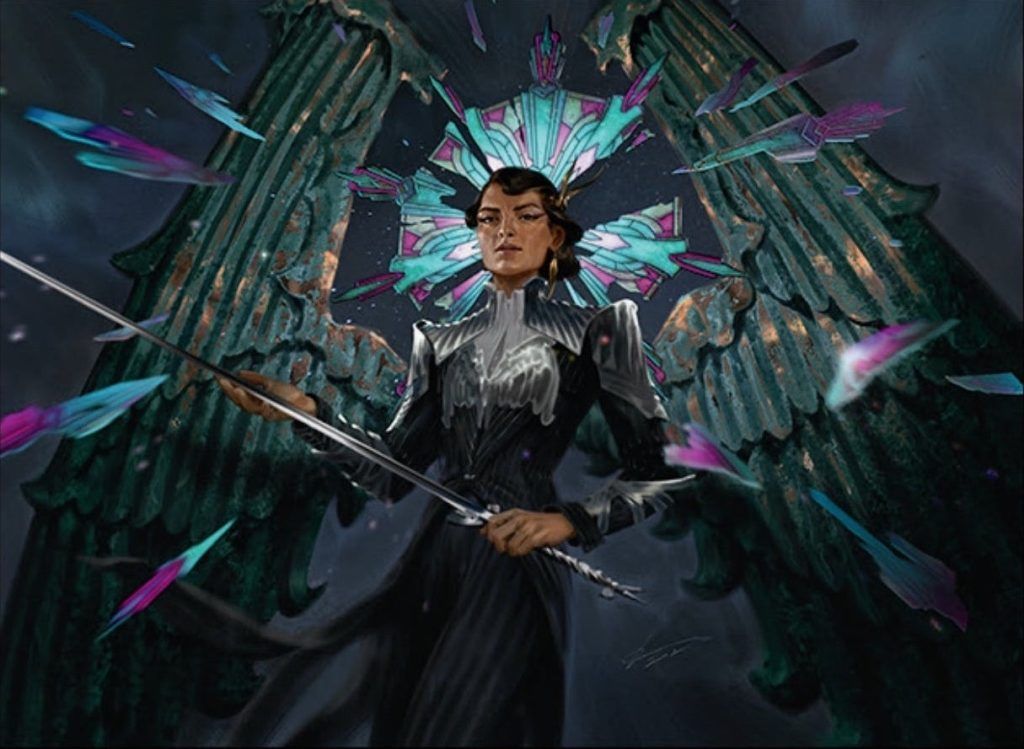
Sanctuary Warden | Illustration by Johannes Voss
I hope you’re excited about this set as I am. Even if the world doesn’t resonate with you, I can assure you that the gameplay of a multicolored Draft set is bound to be worth it, and I really hope this set delivers.
What do you think about this set? Are you excited for the new Draft format, or do the 3-color archetypes seem like a bit much to you? Let me know in the comments down below or over in Draftsim’s Discord.
Two important reminders: First, if you want card ratings like this in-app while you play MTGA, you can do that for free with Arena Tutor. So please definitely do that!
Secondly, you can practice drafting and sealed (also for free) before the set comes out on our draft simulator:

Until next time, take care of yourselves and enjoy your prereleases.
Follow Draftsim for awesome articles and set updates: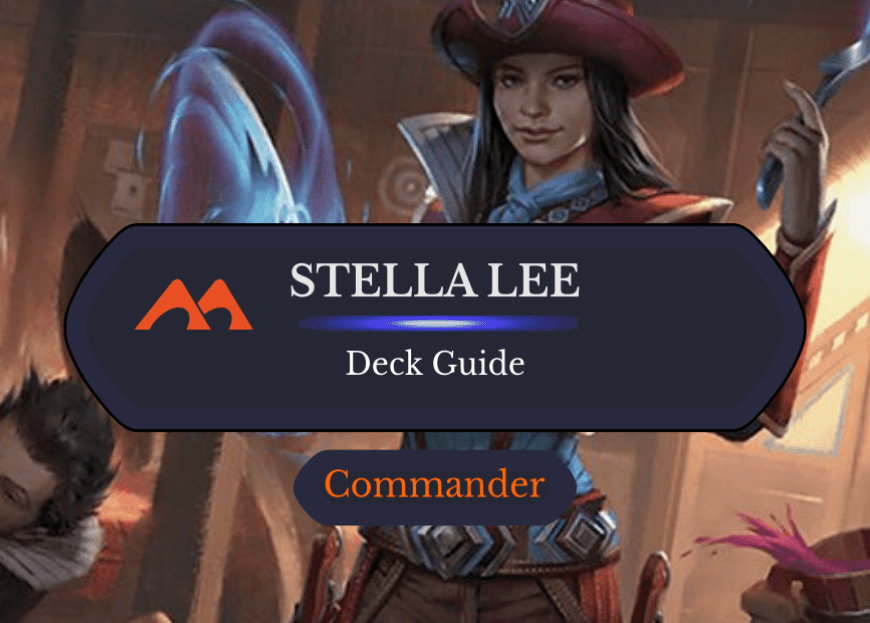
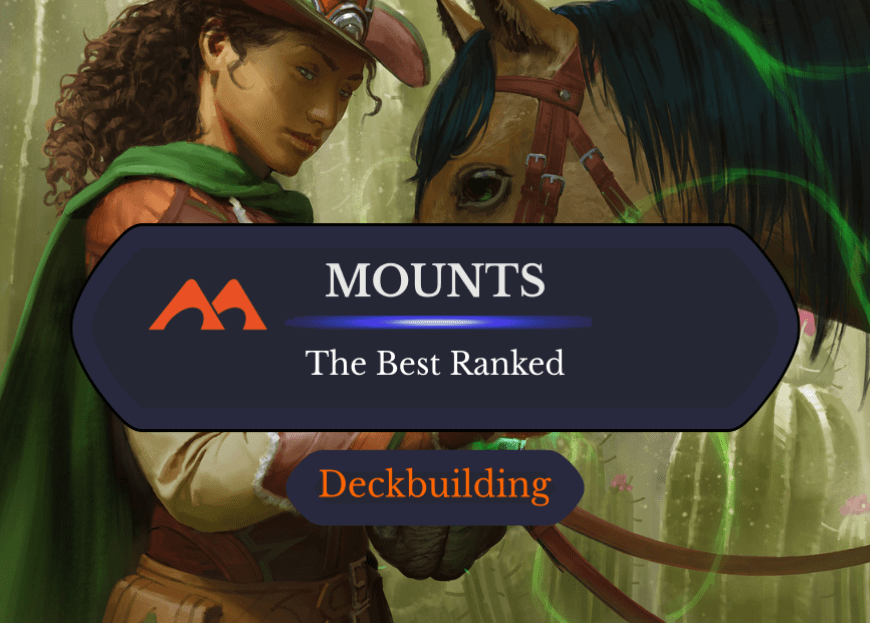
2 Comments
Great article, looking forward to drafting this set. With that being said, I don’t think Rock Lee wore cement shoes 😀
Very detailed and thoughful analysis of the cards. Great work.
Add Comment